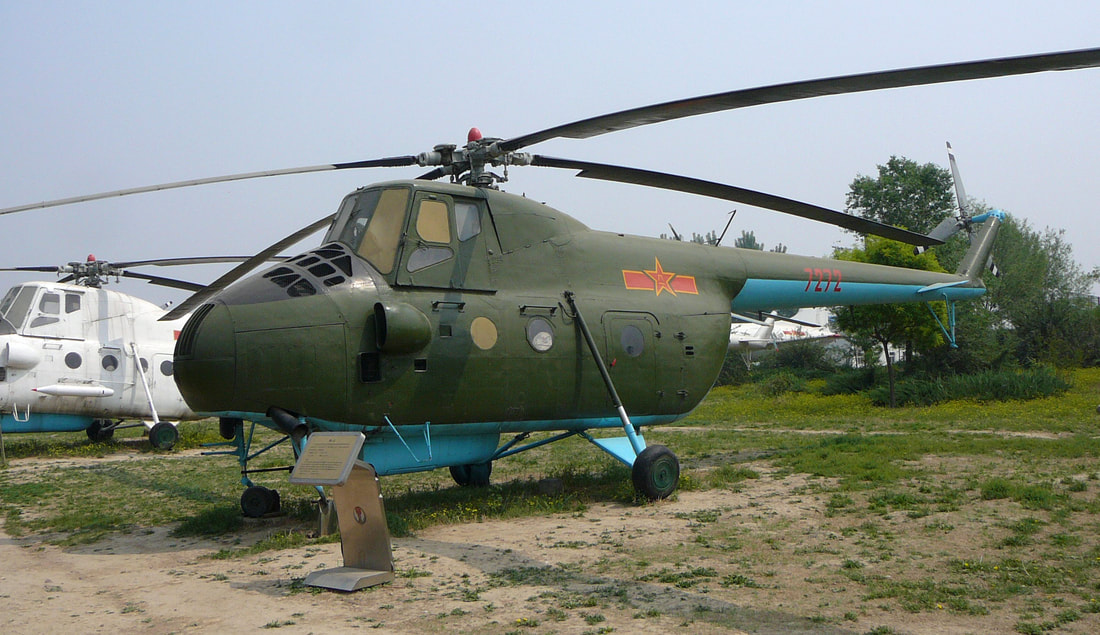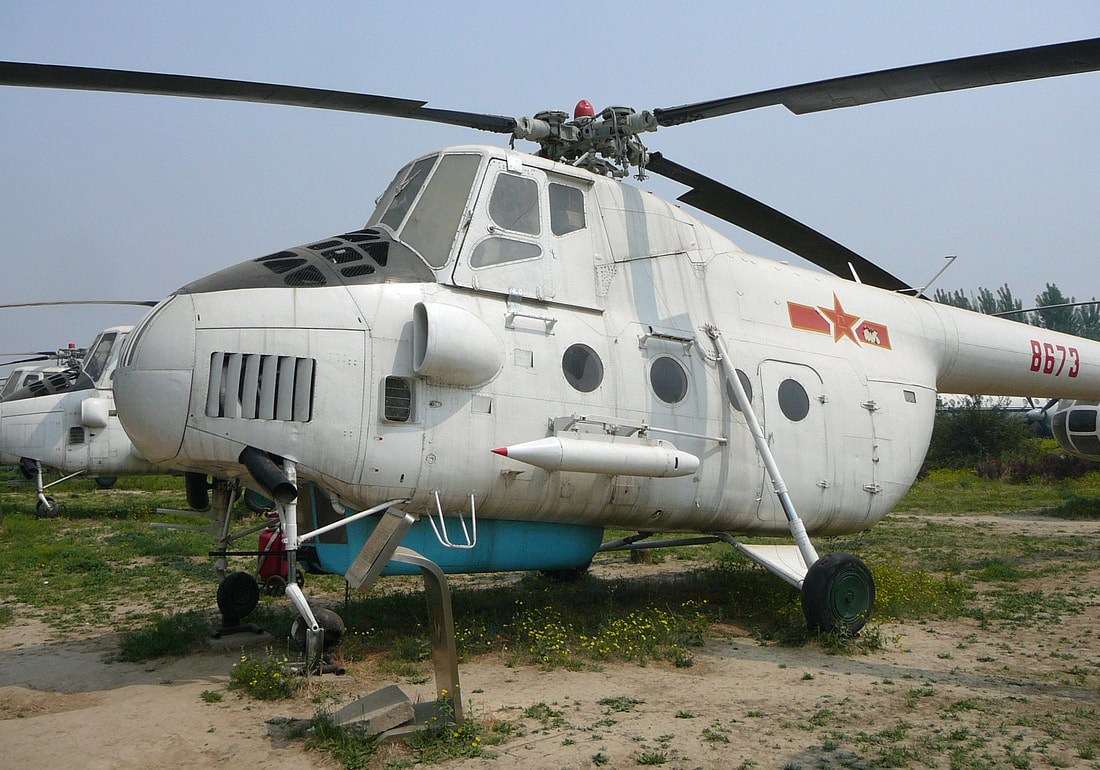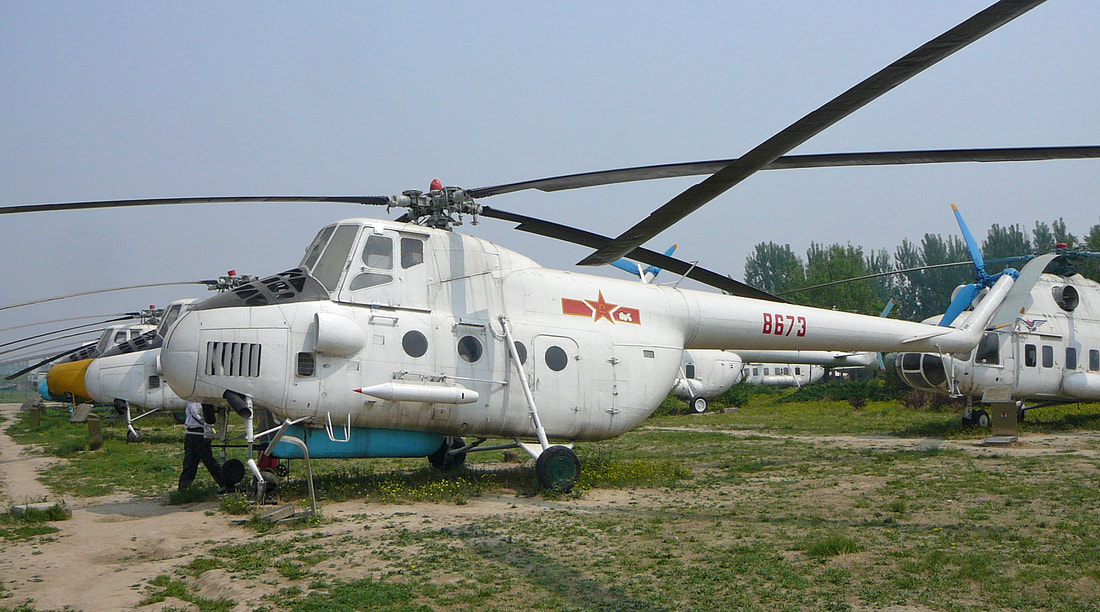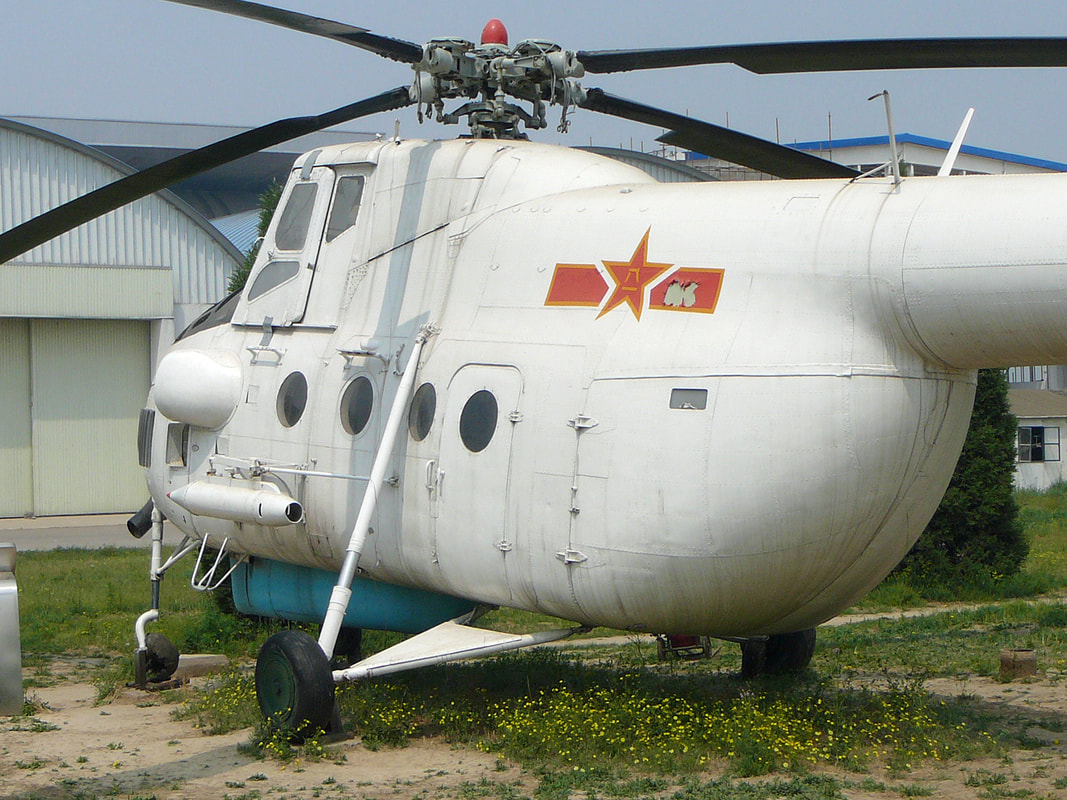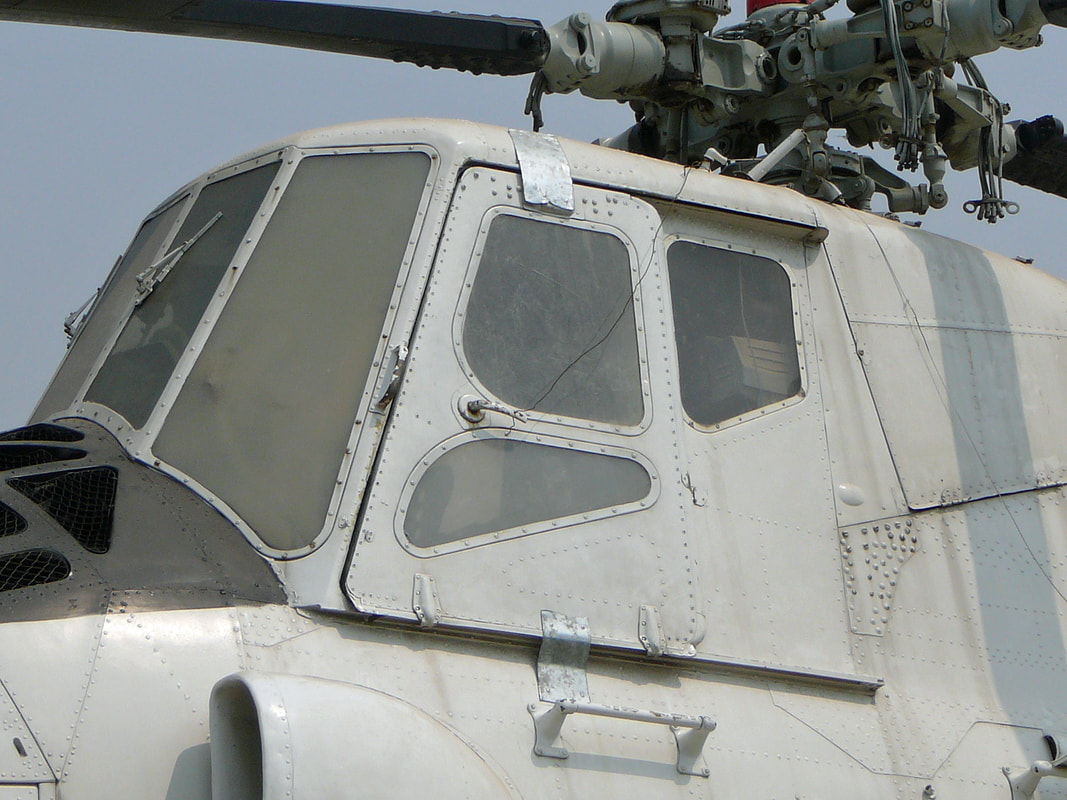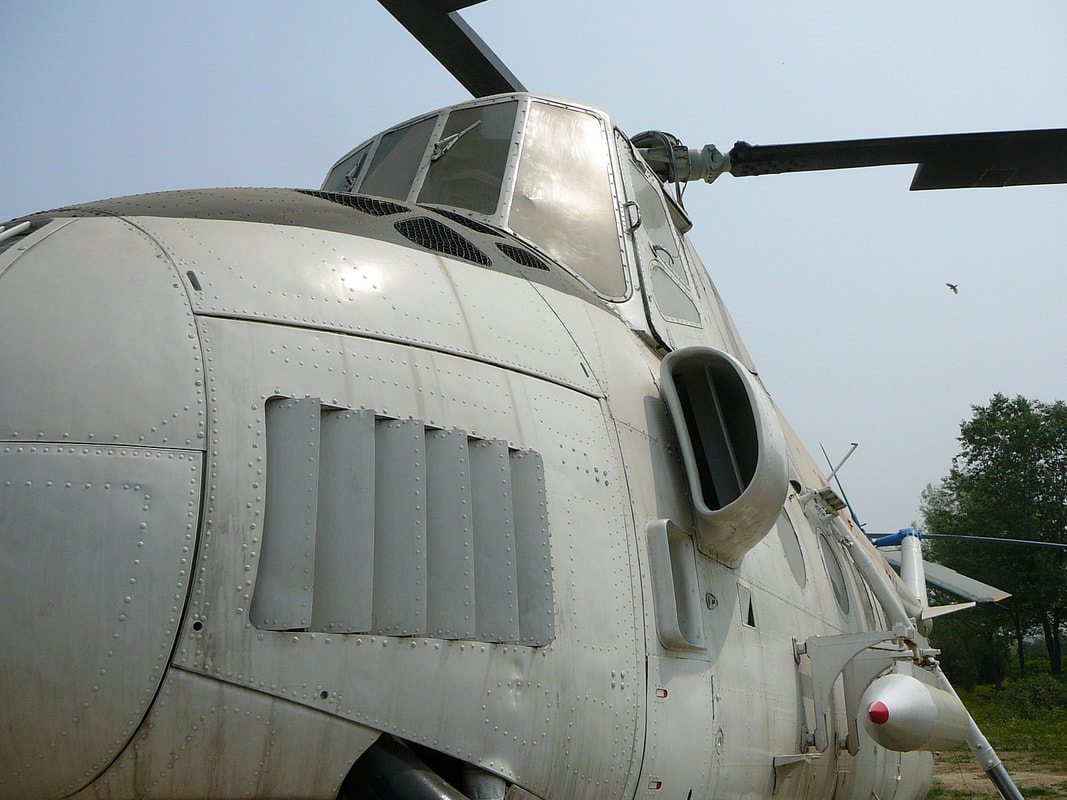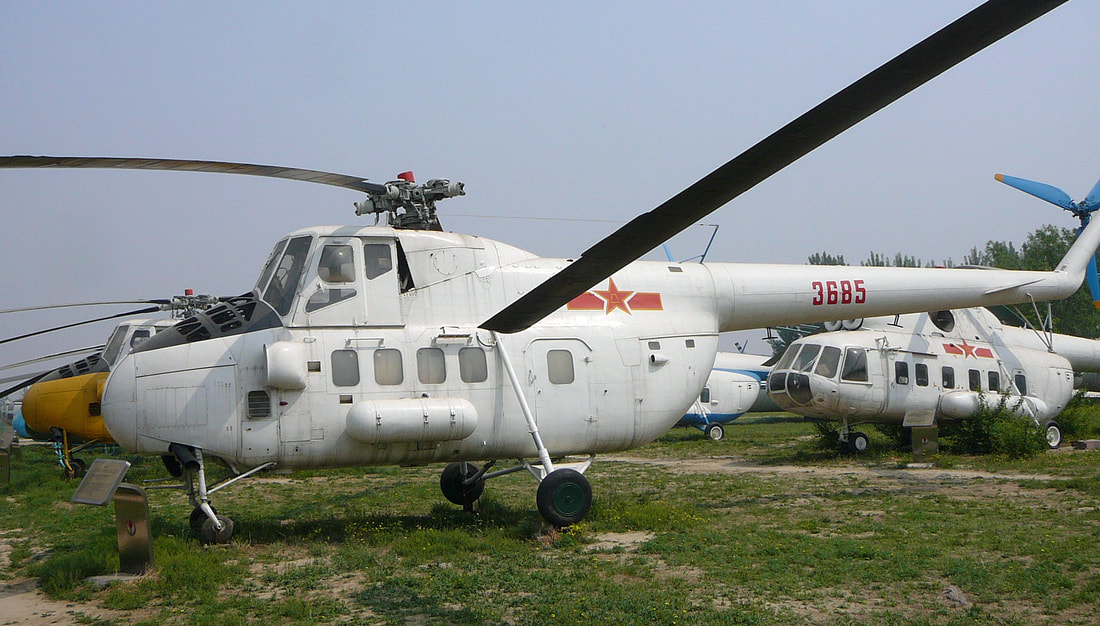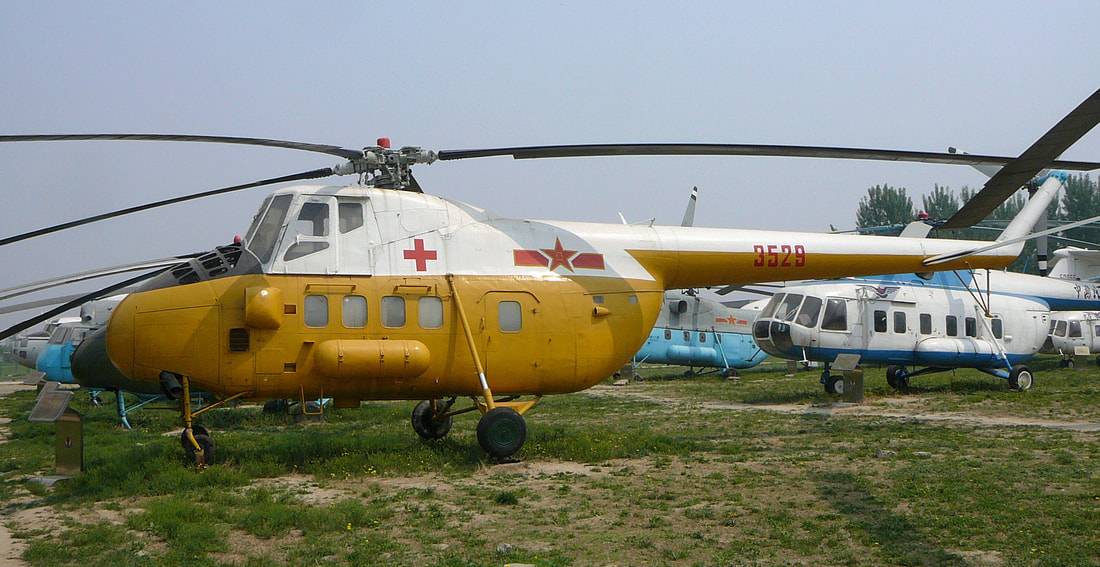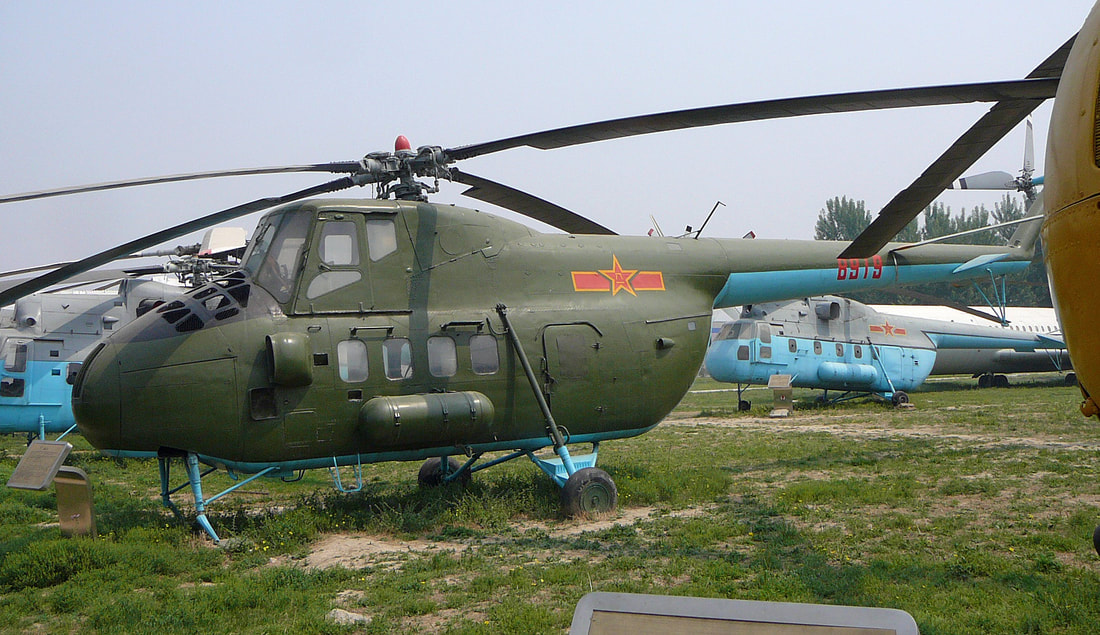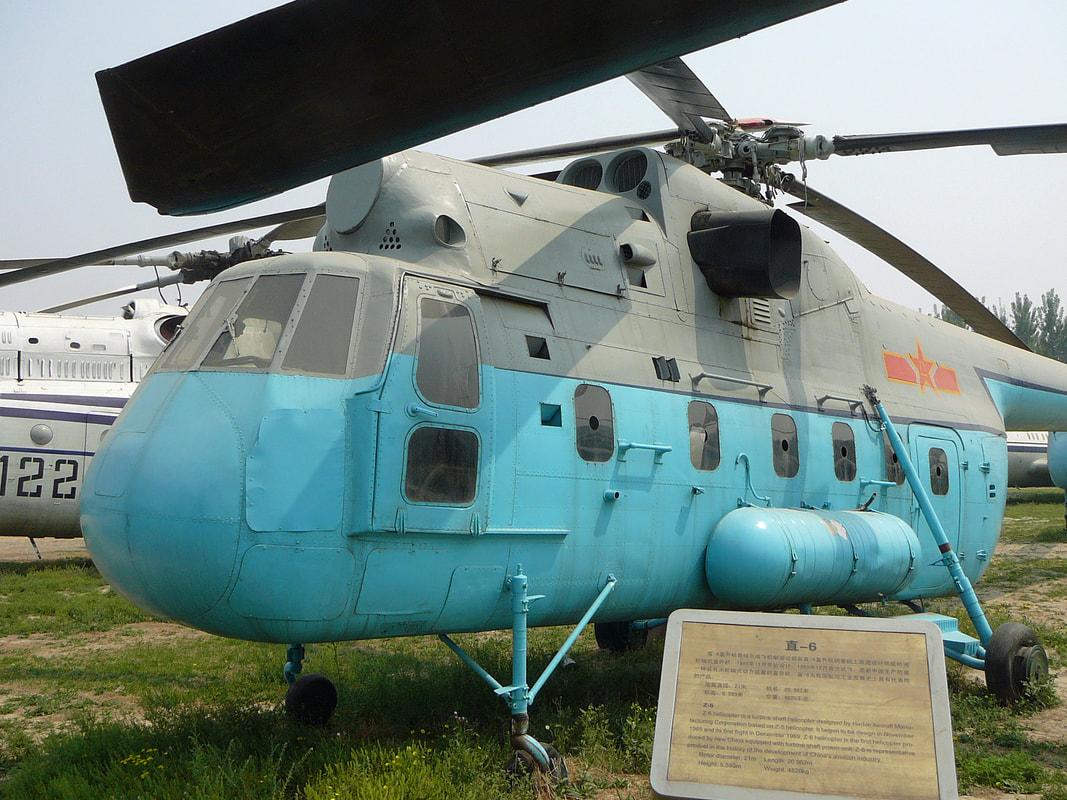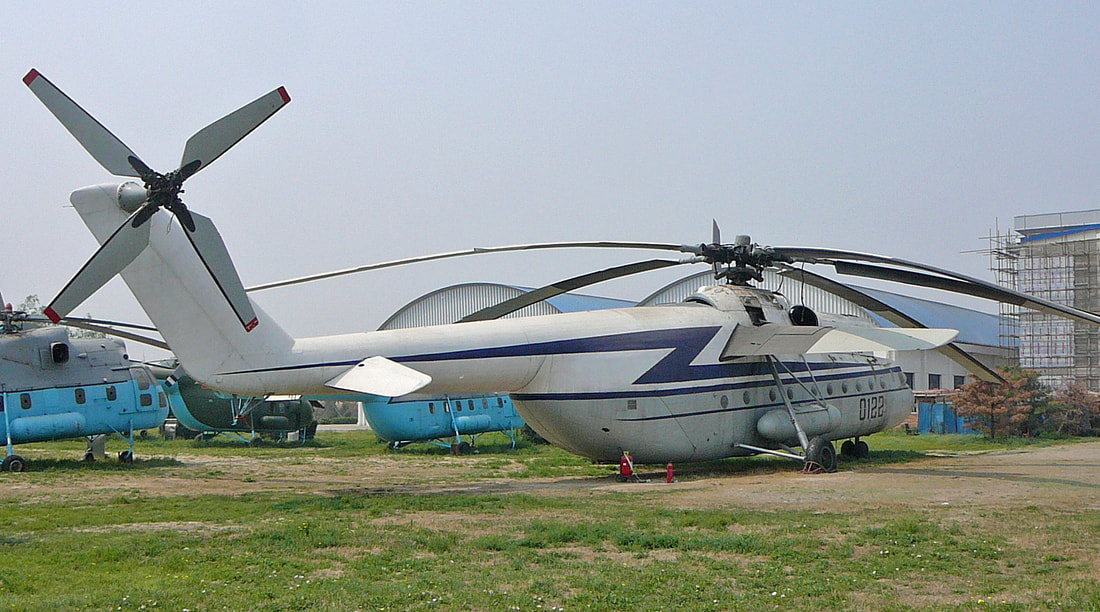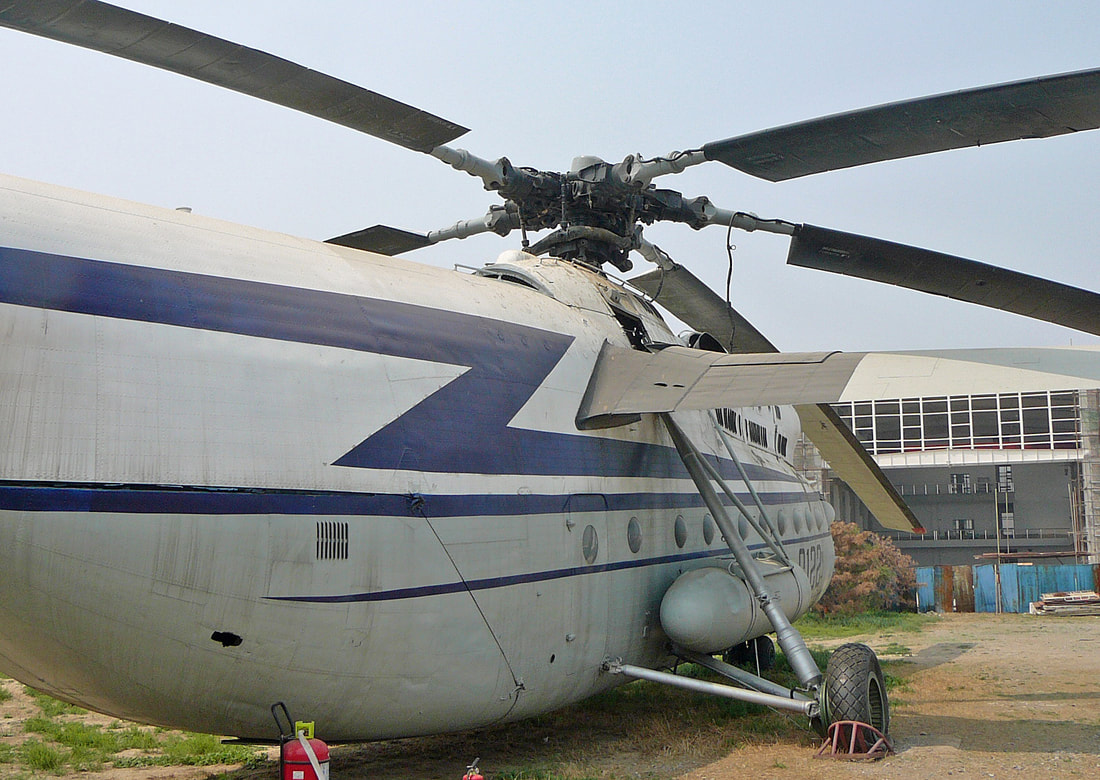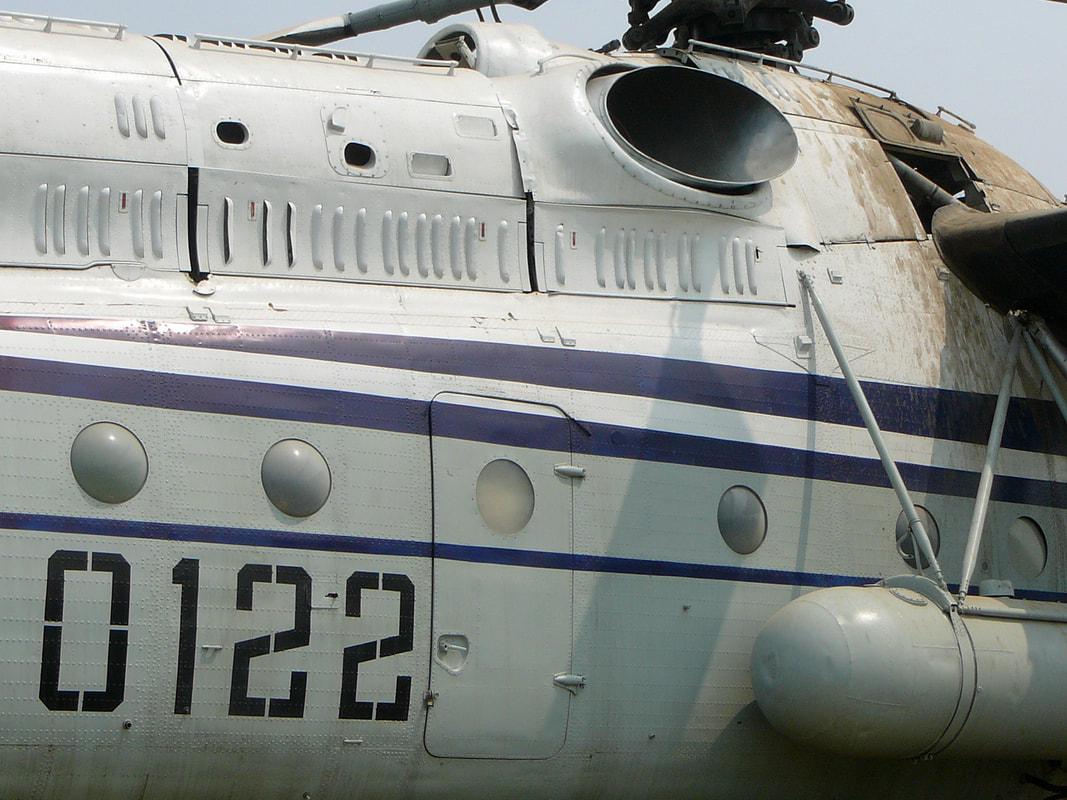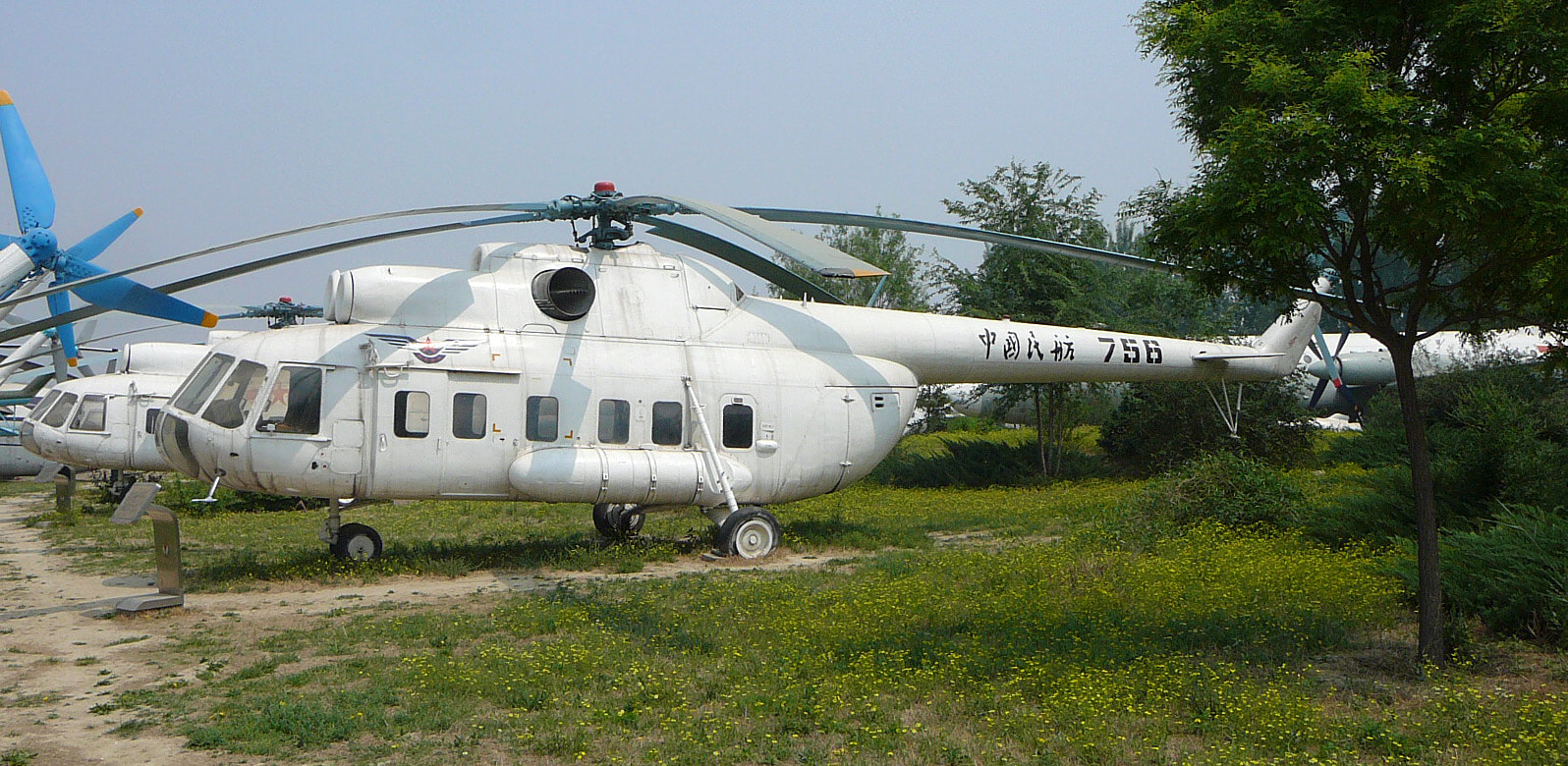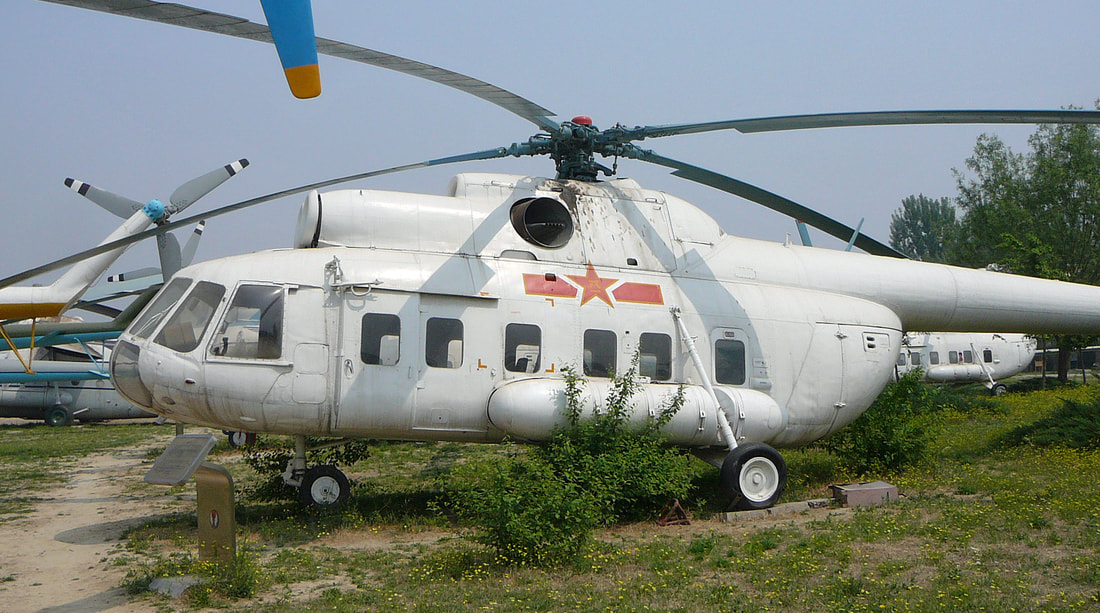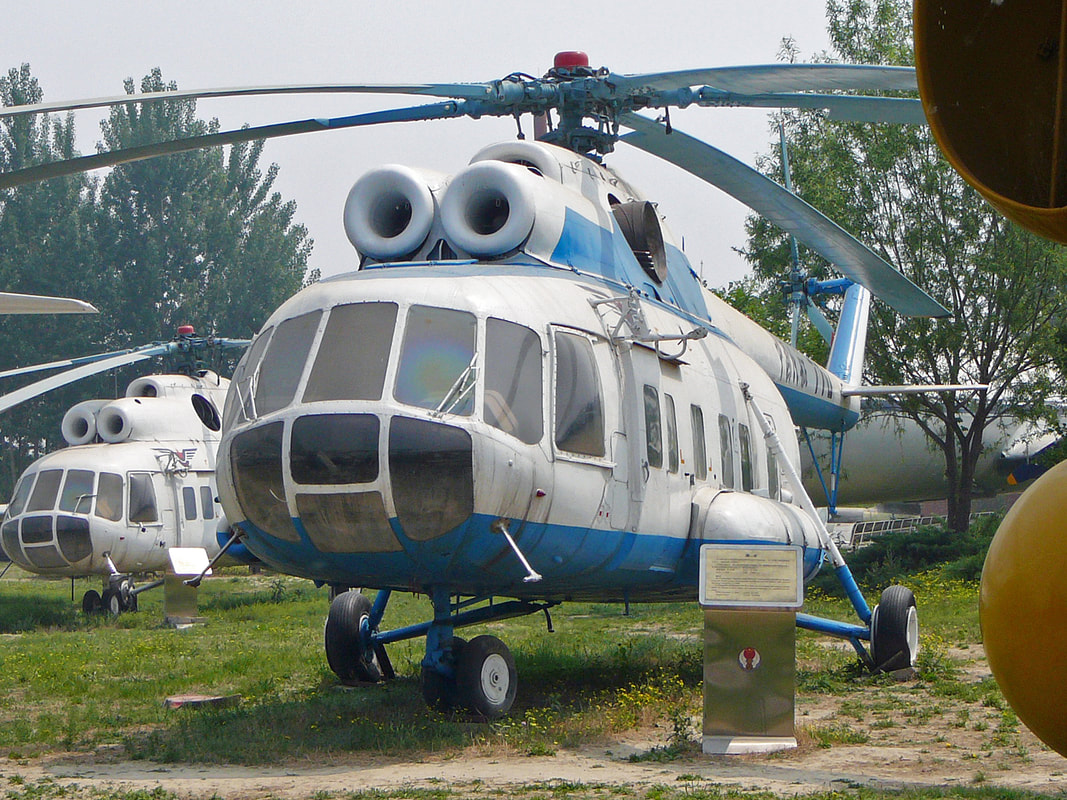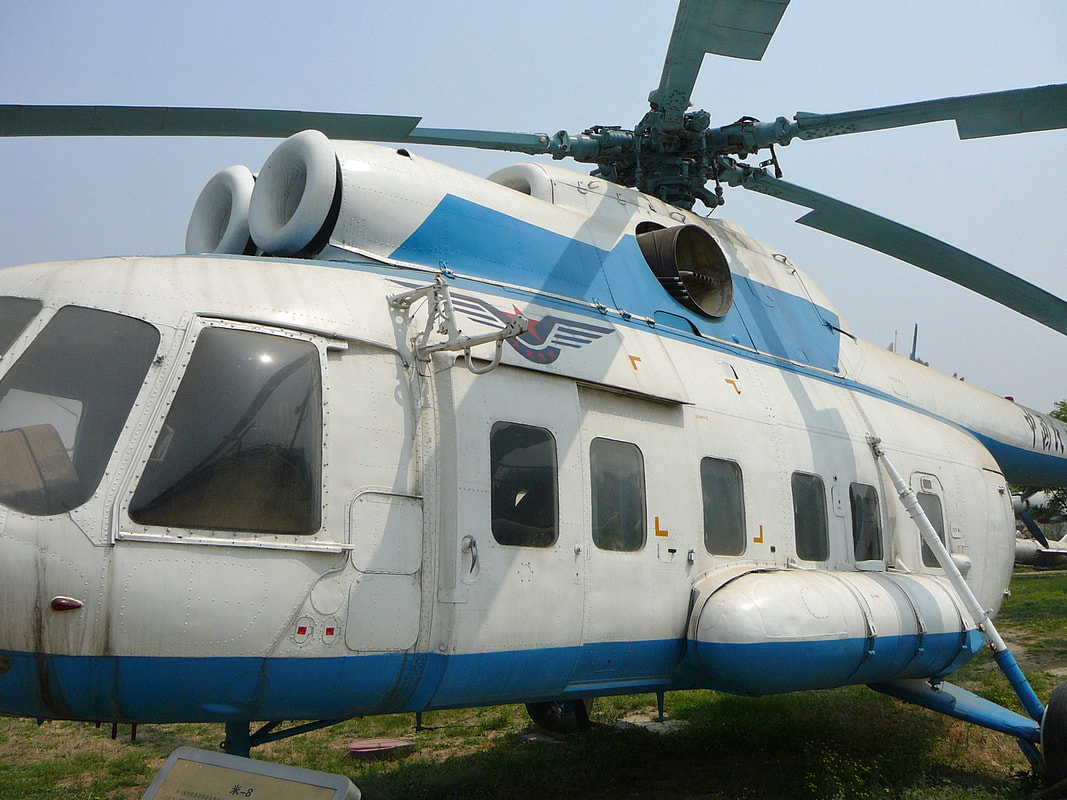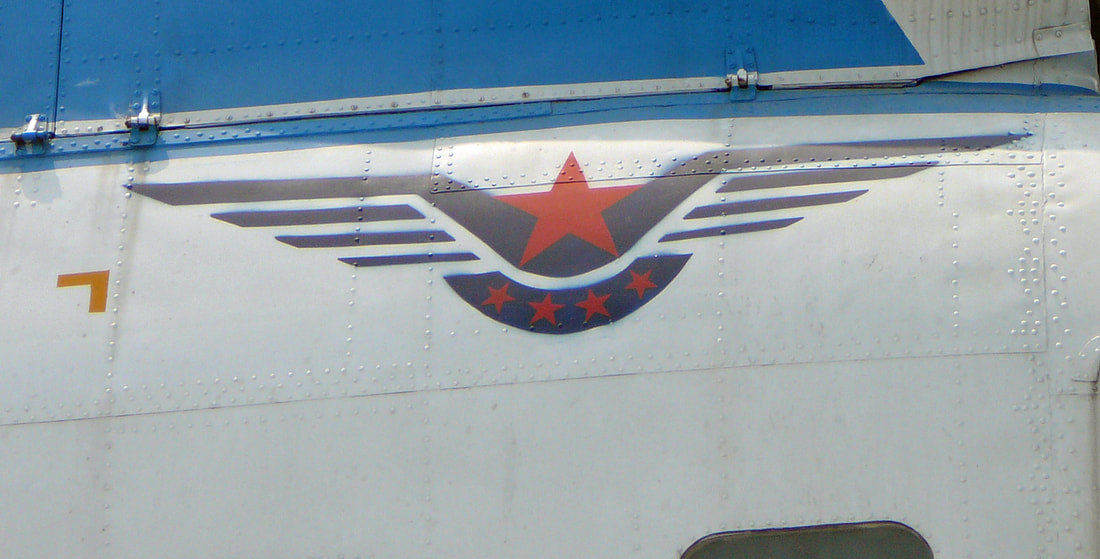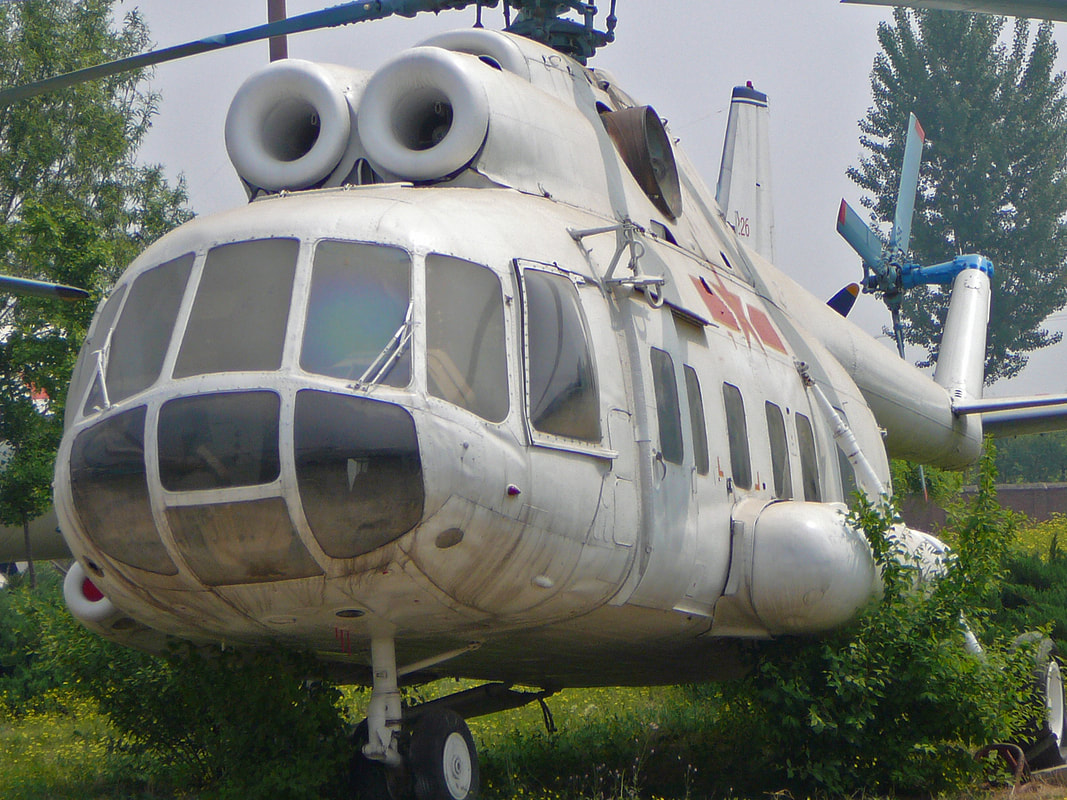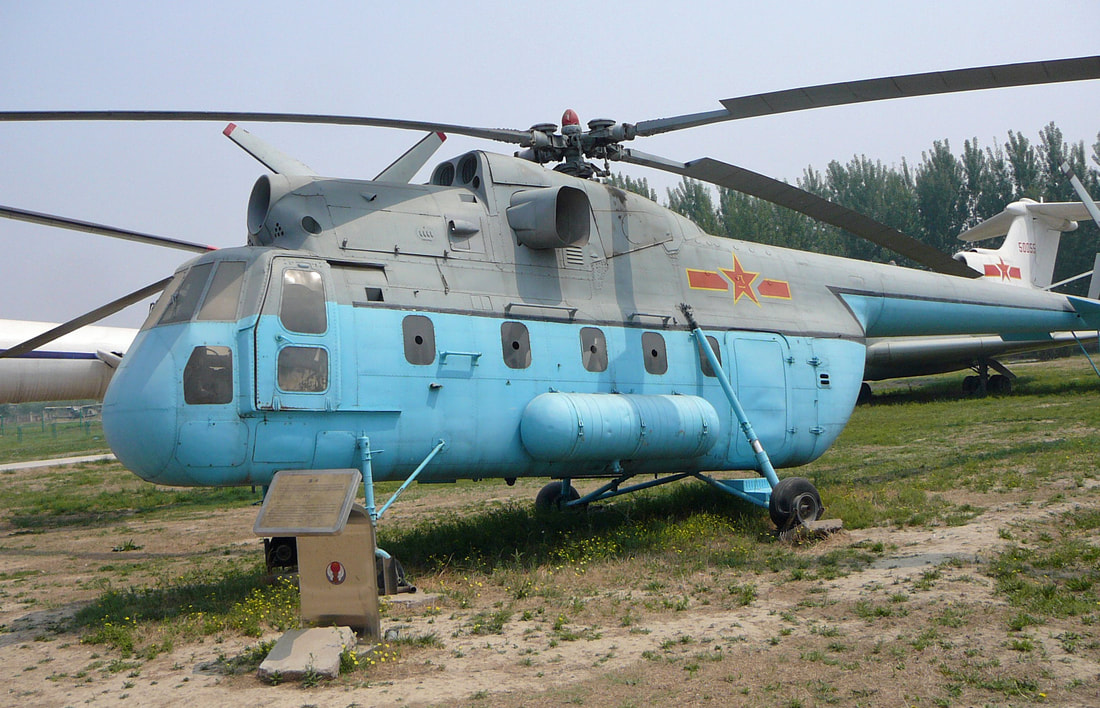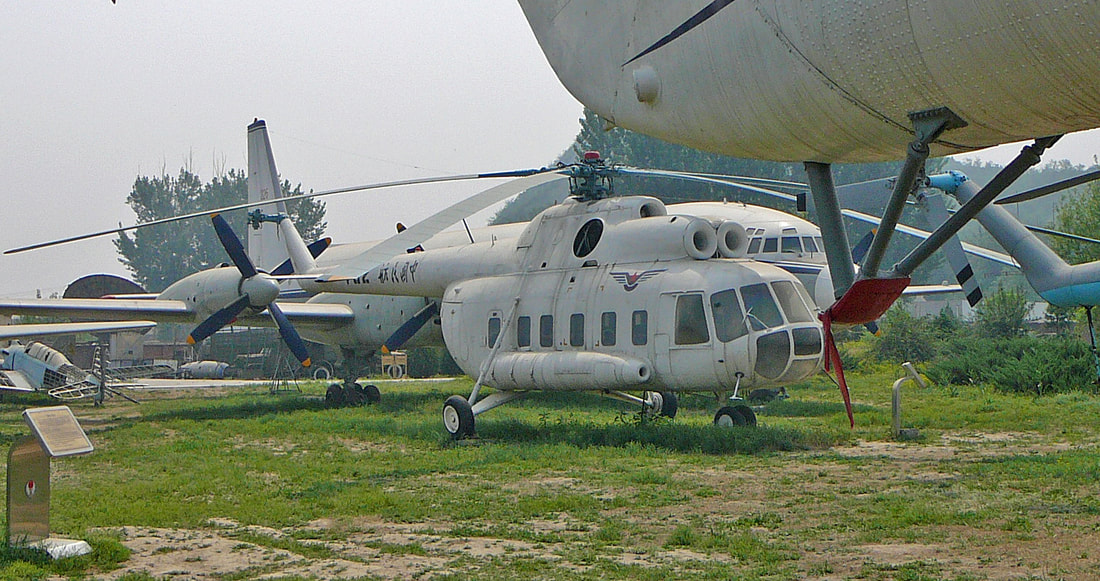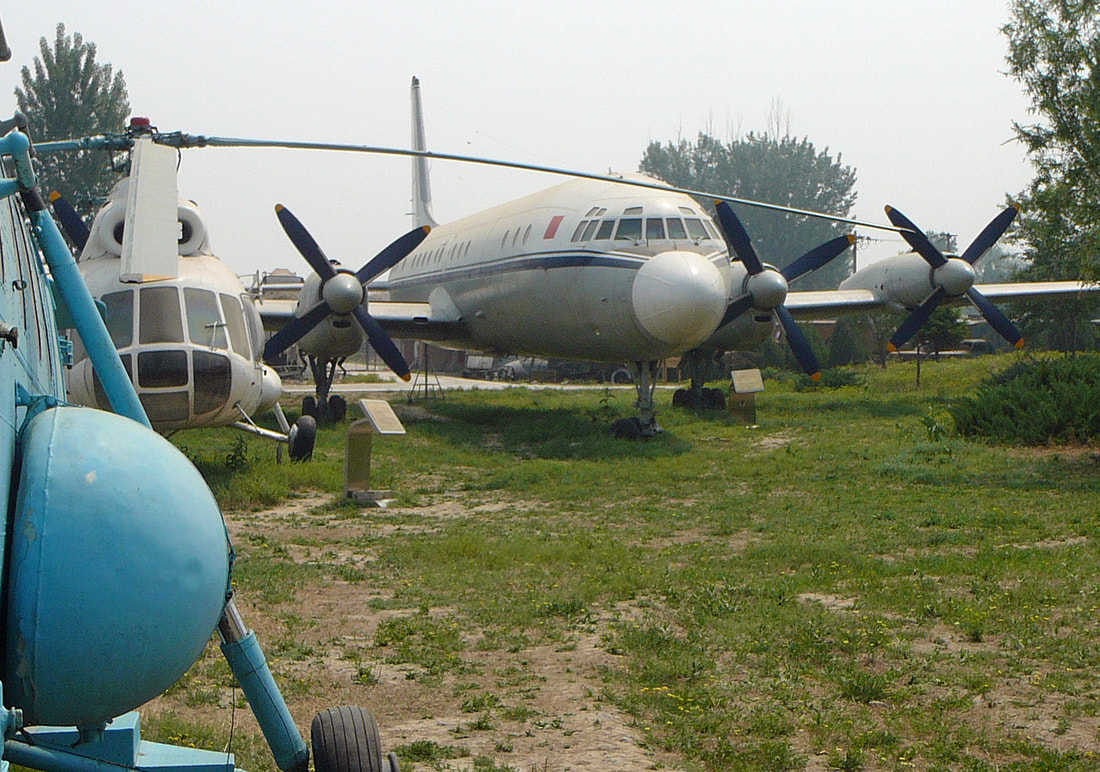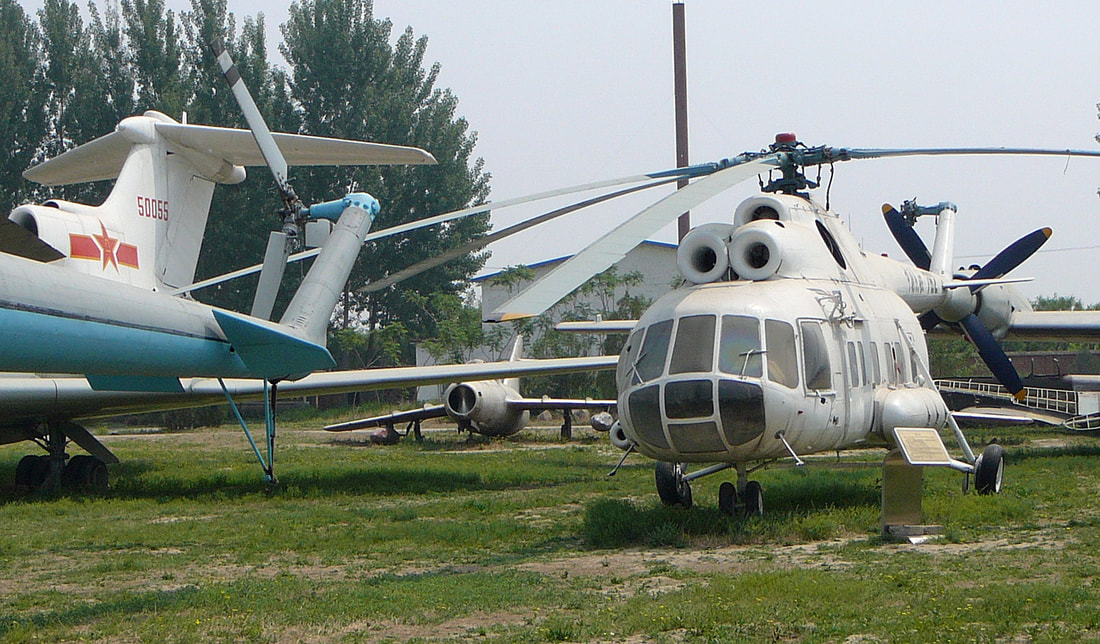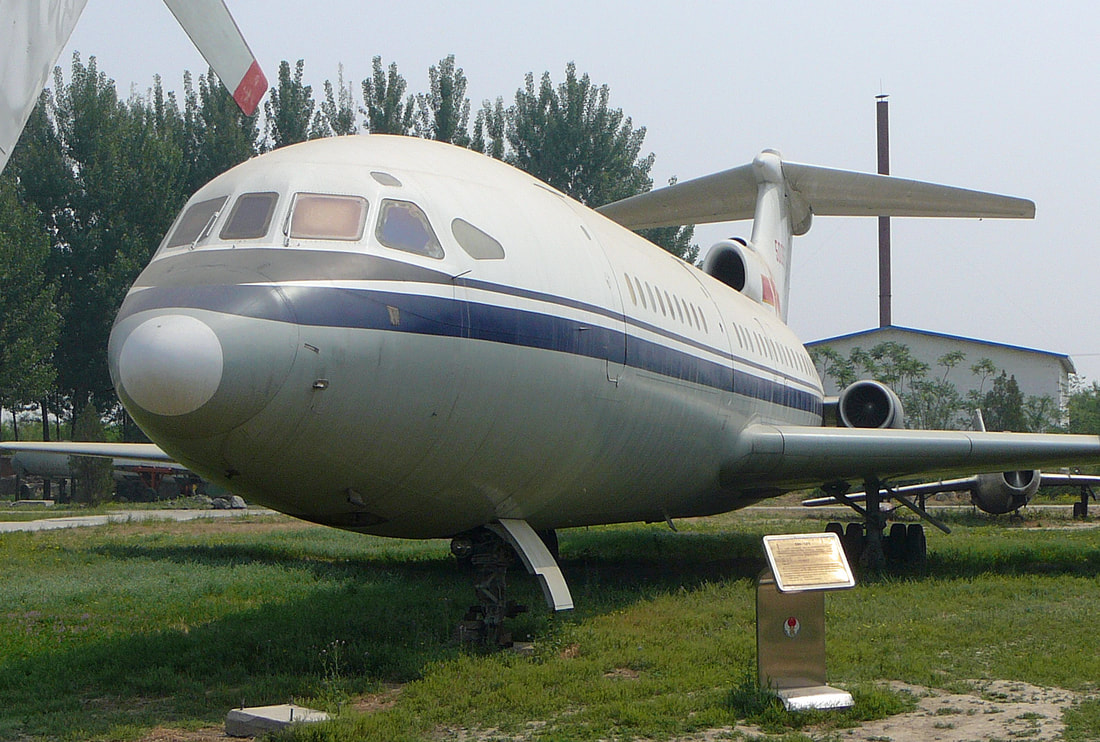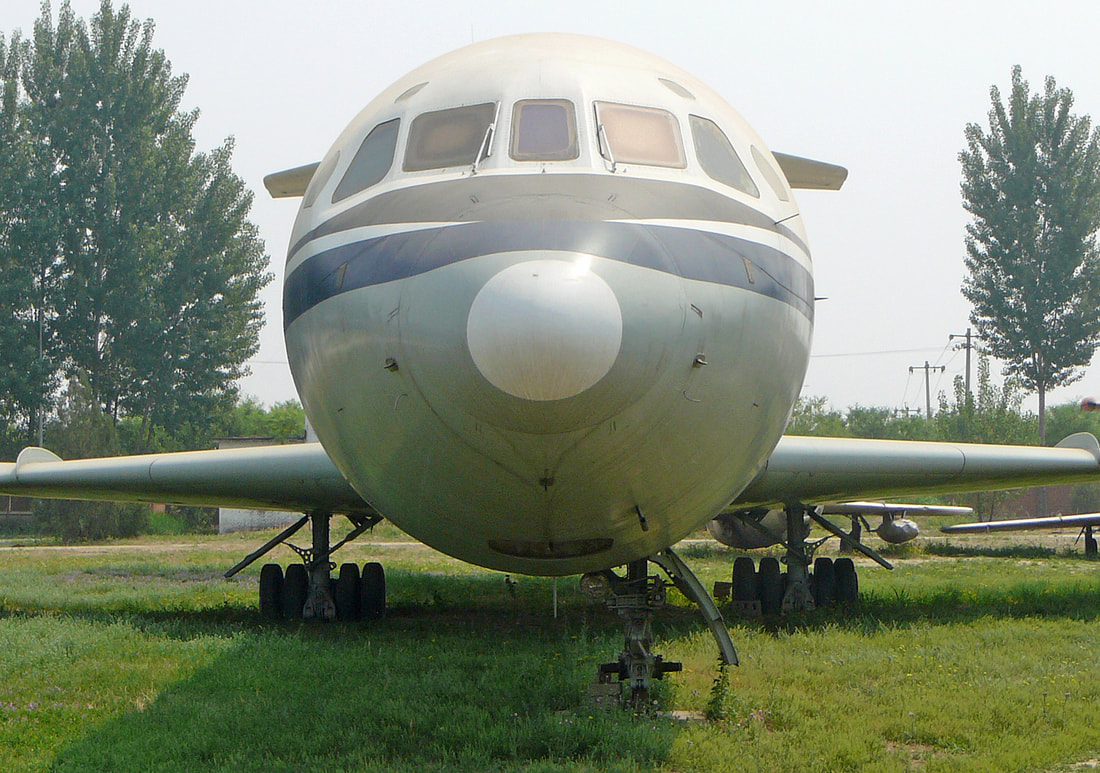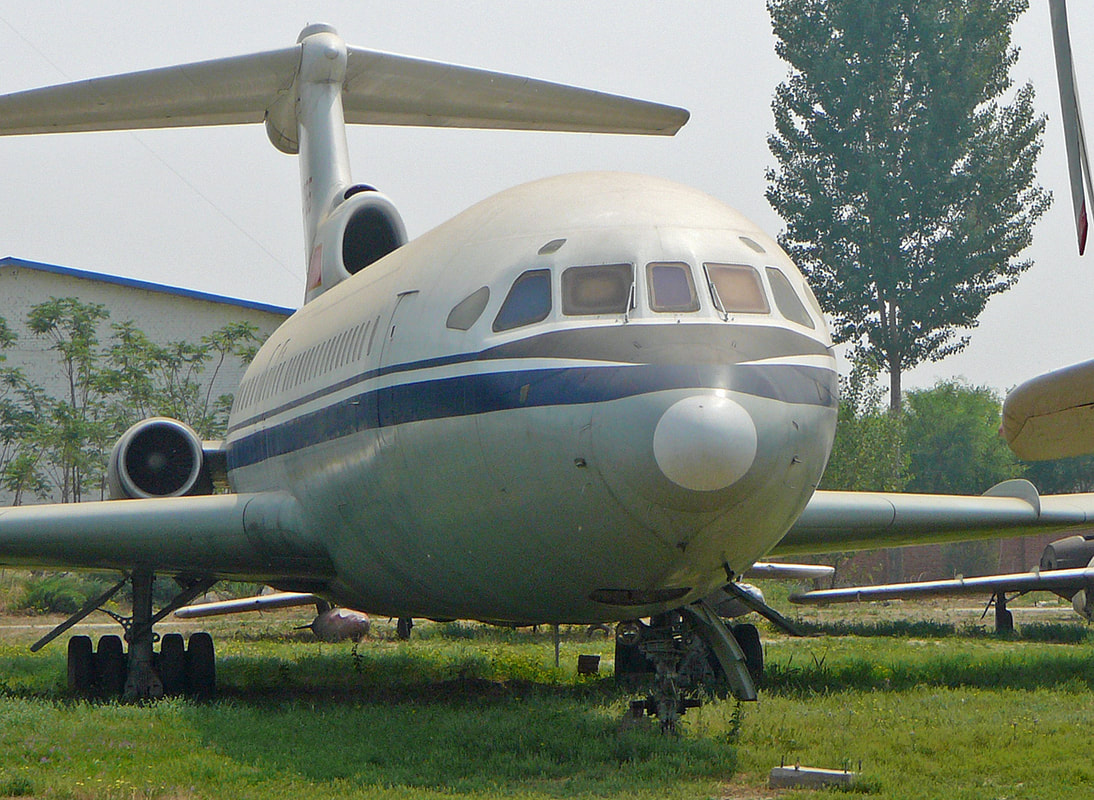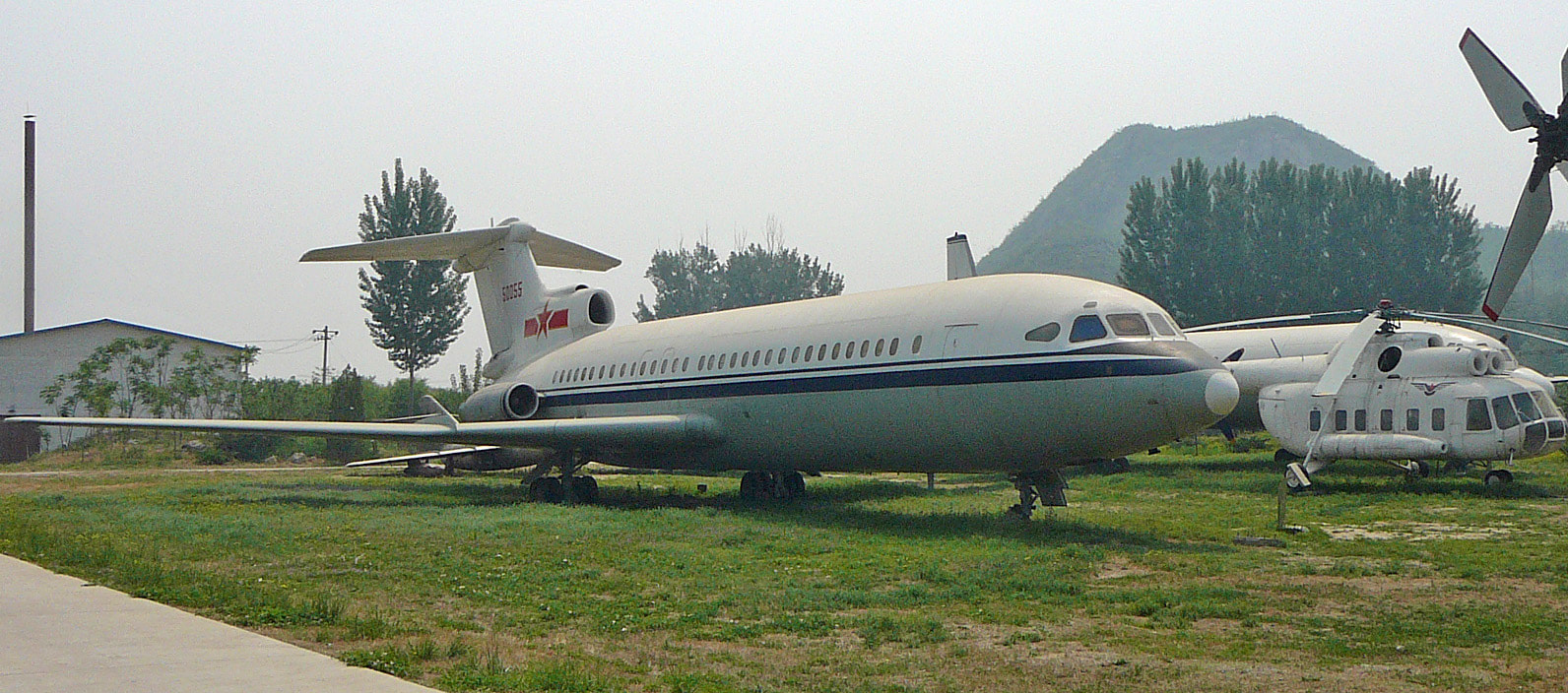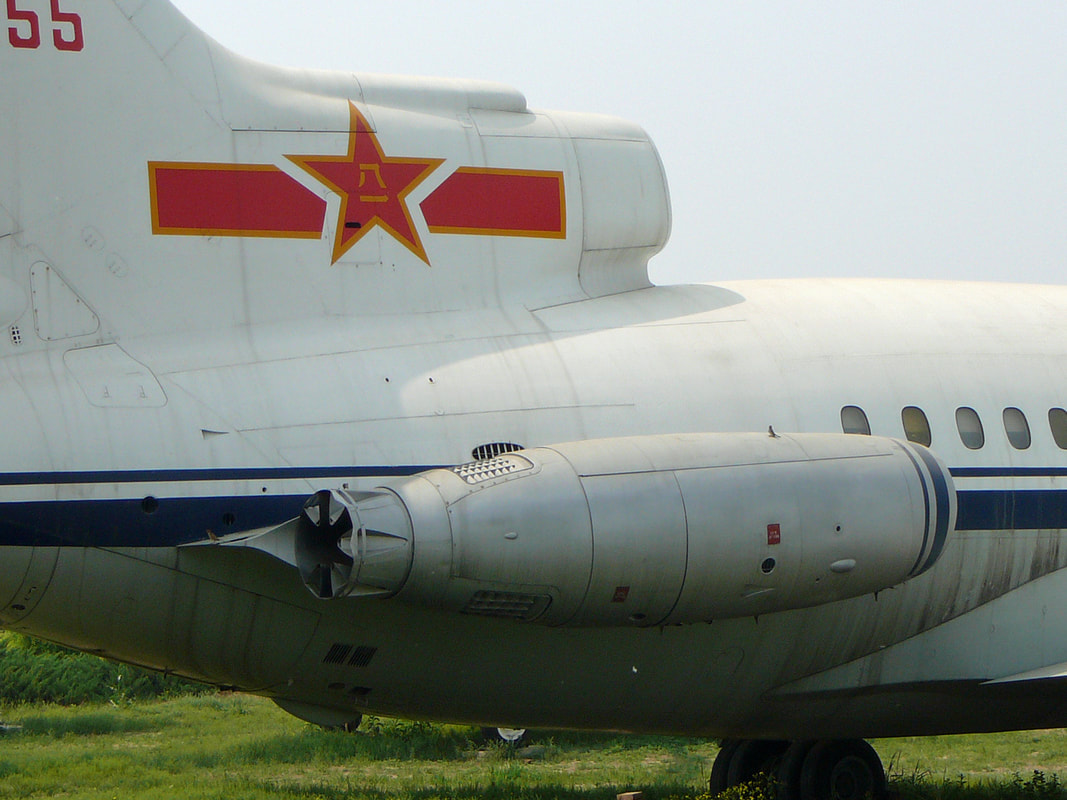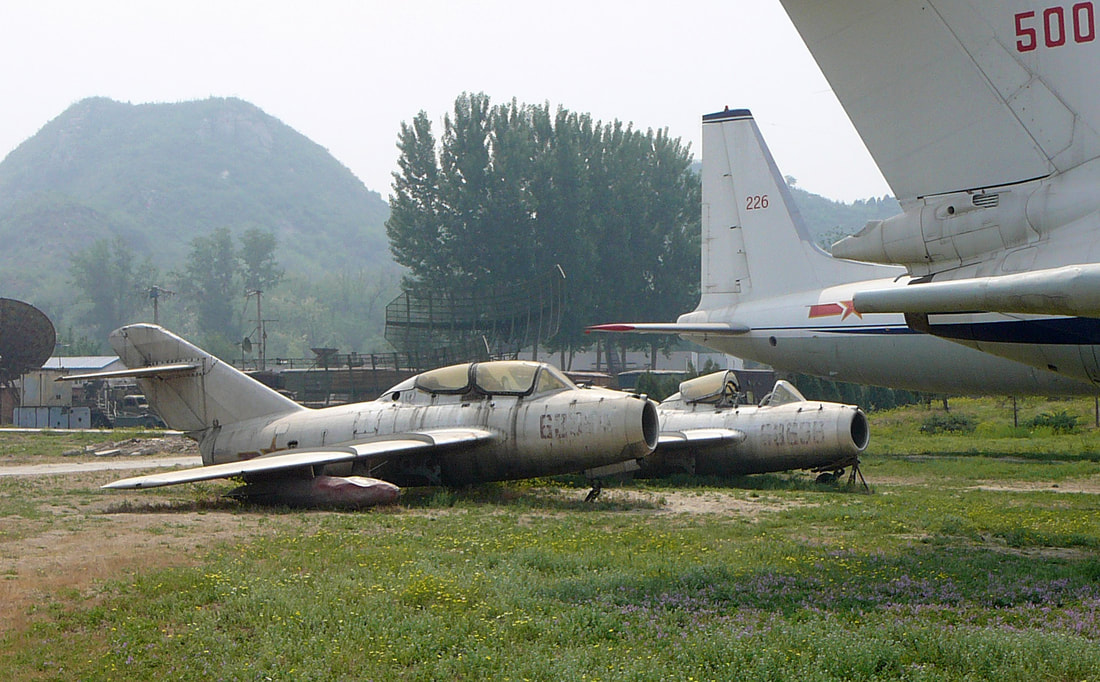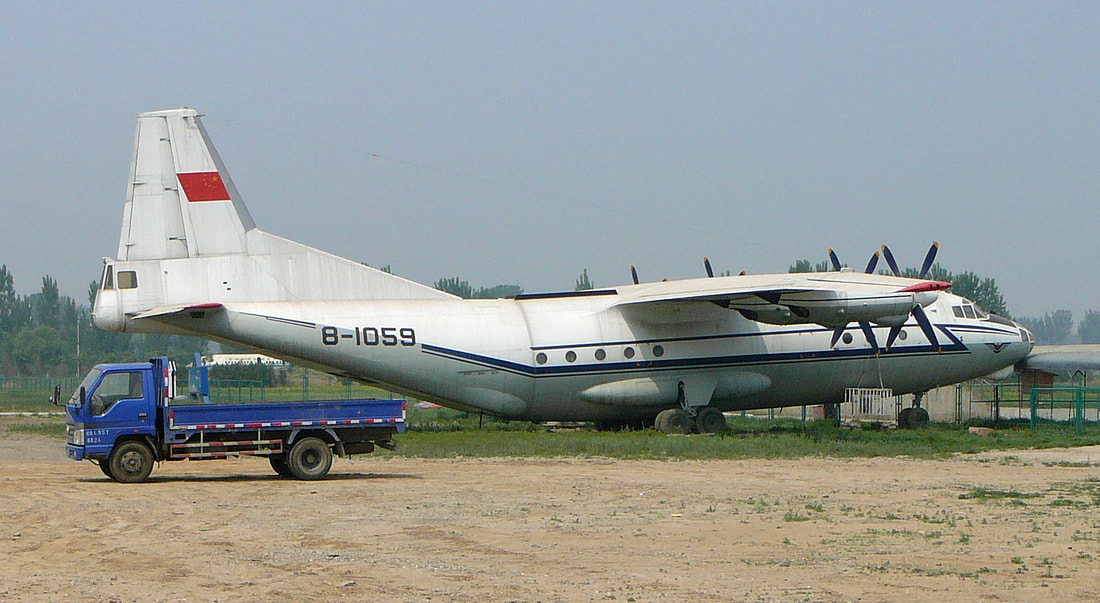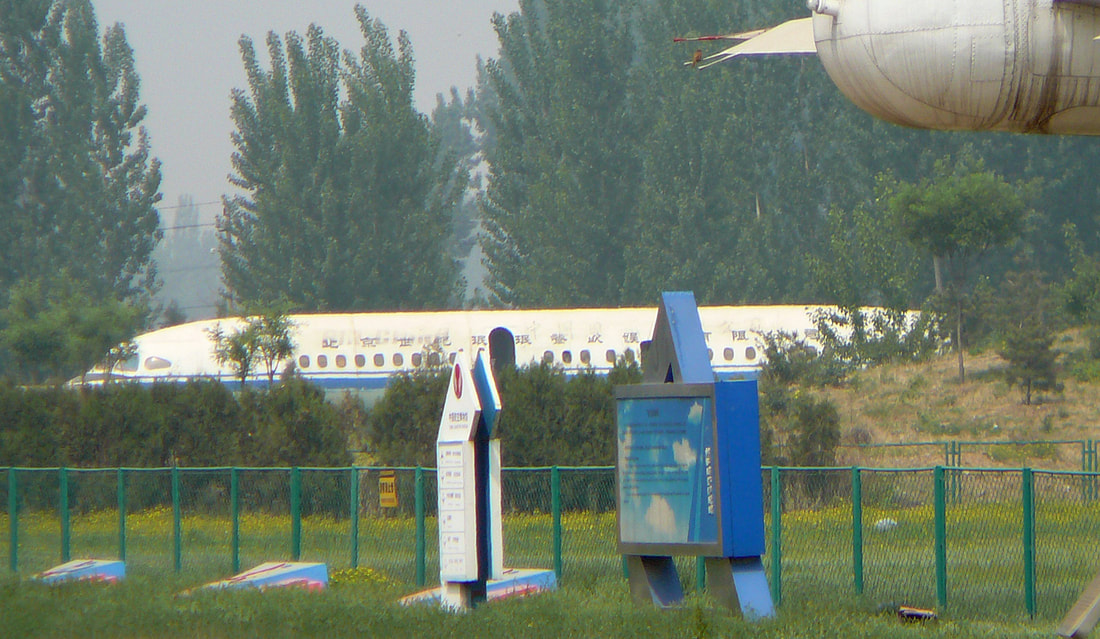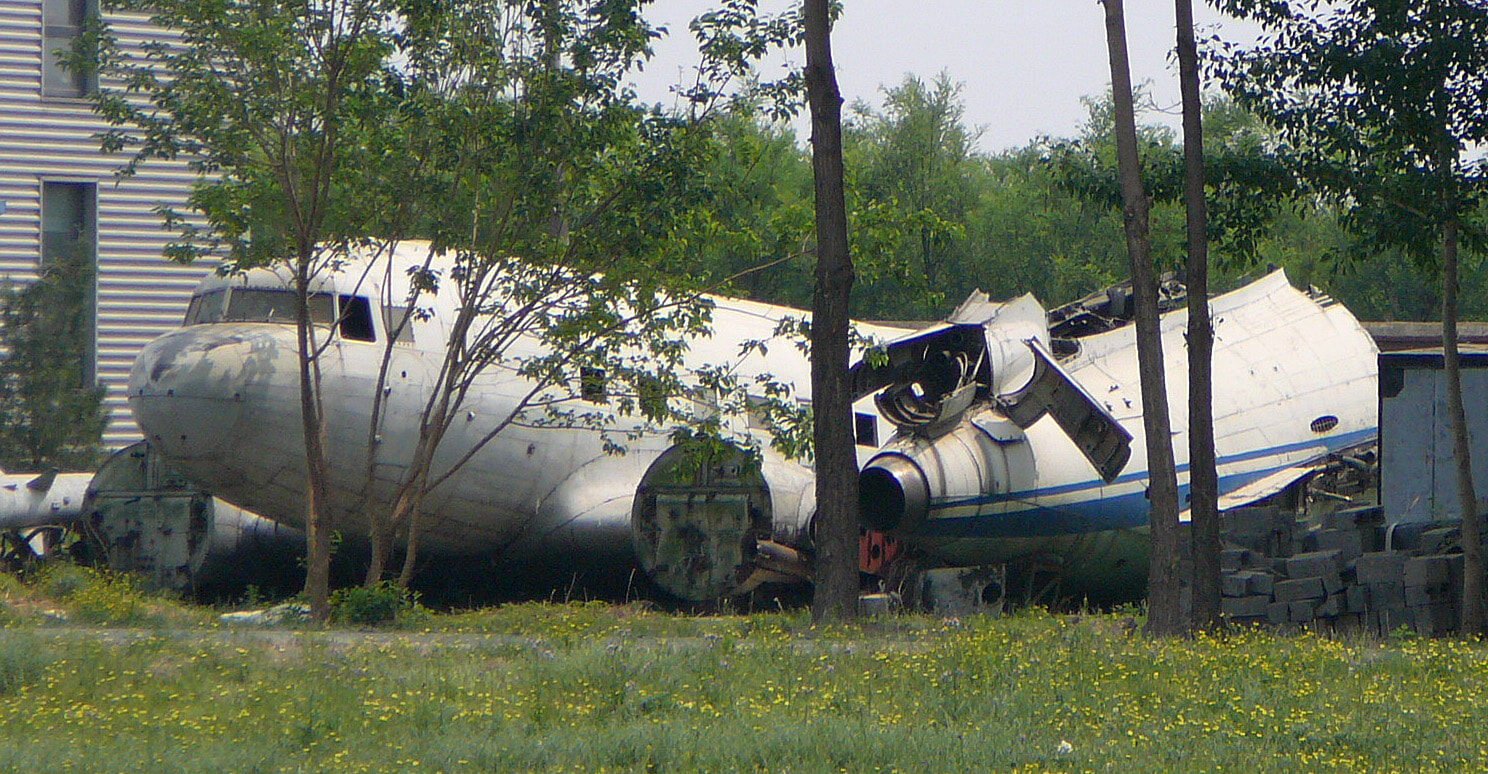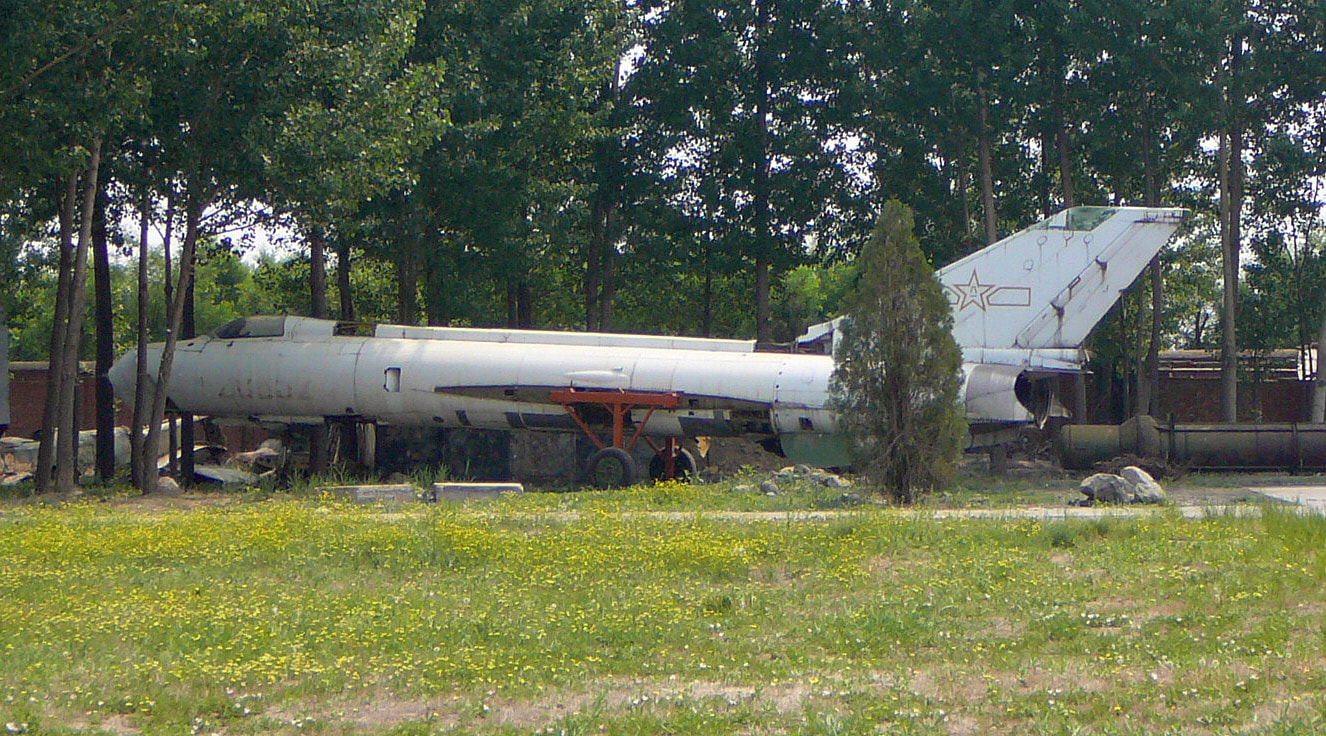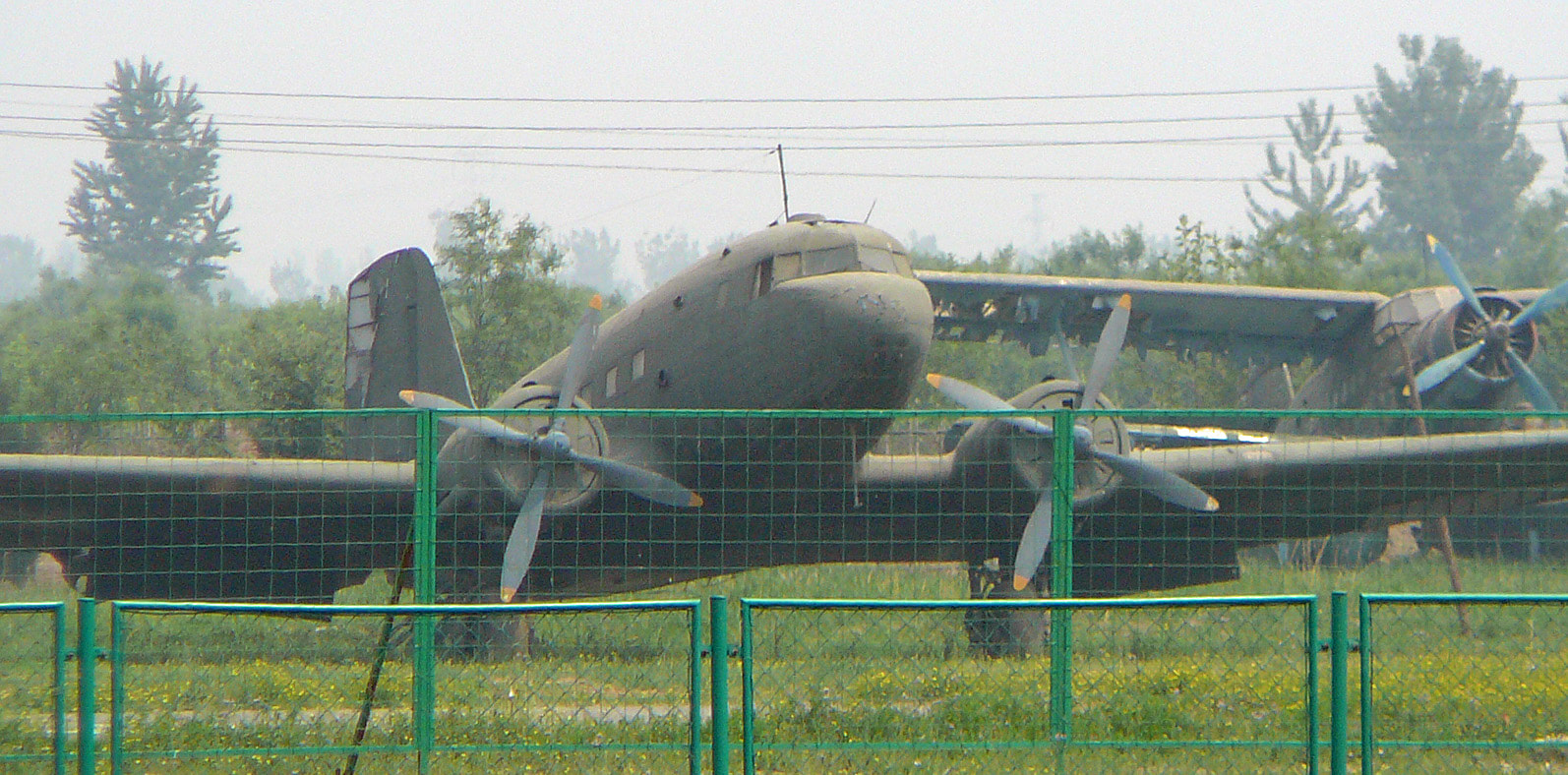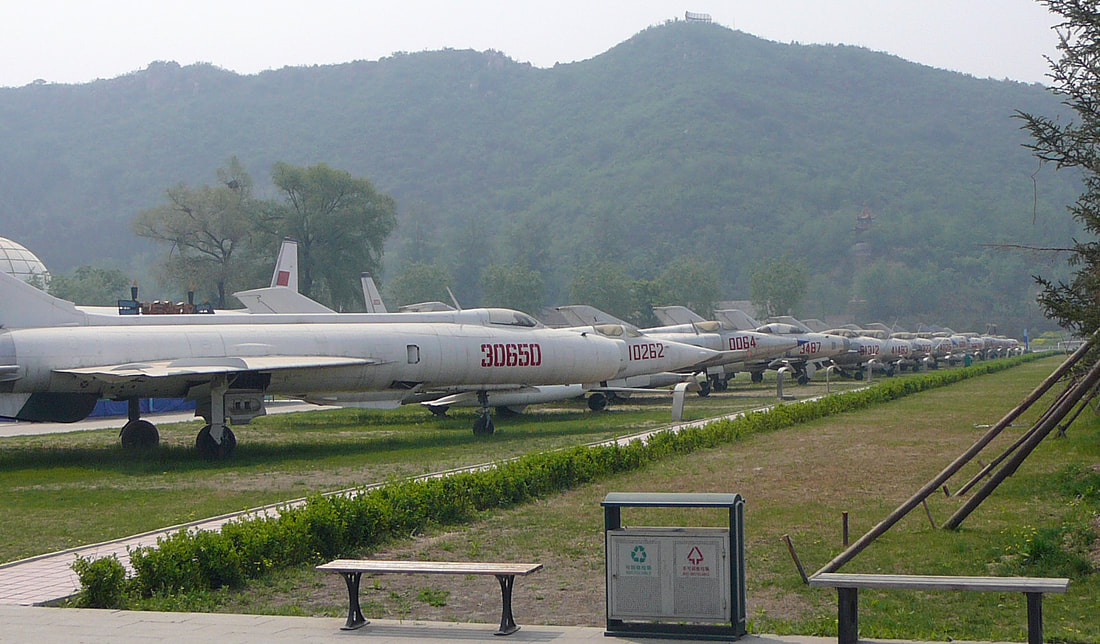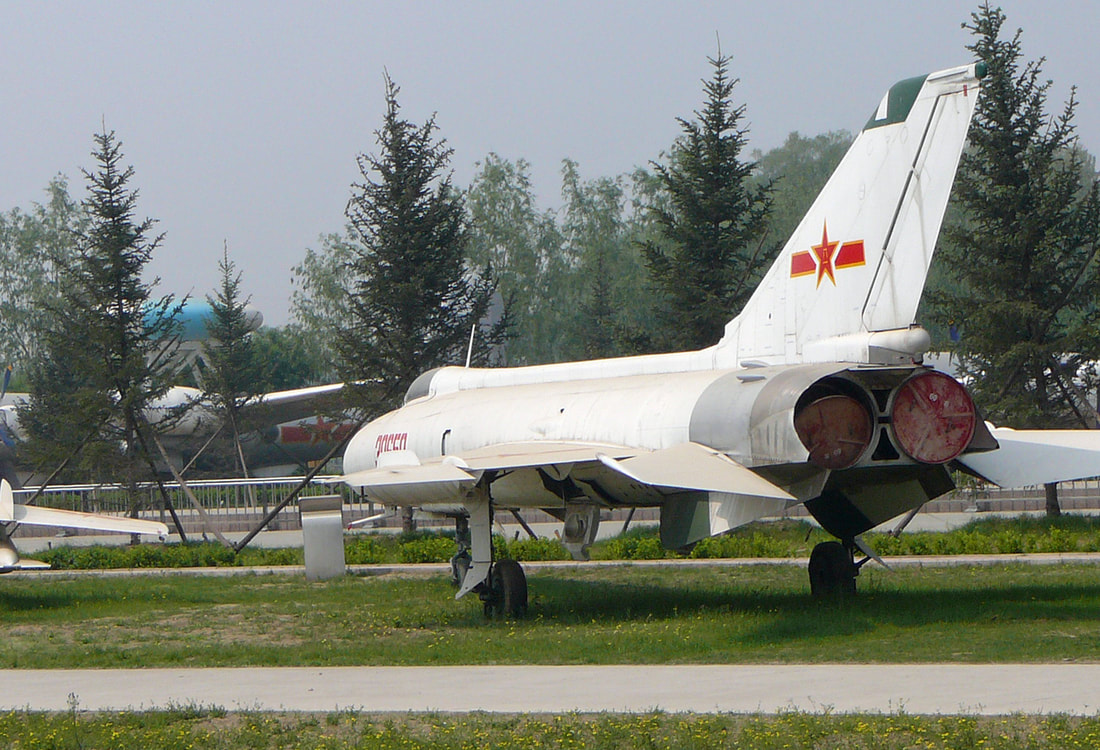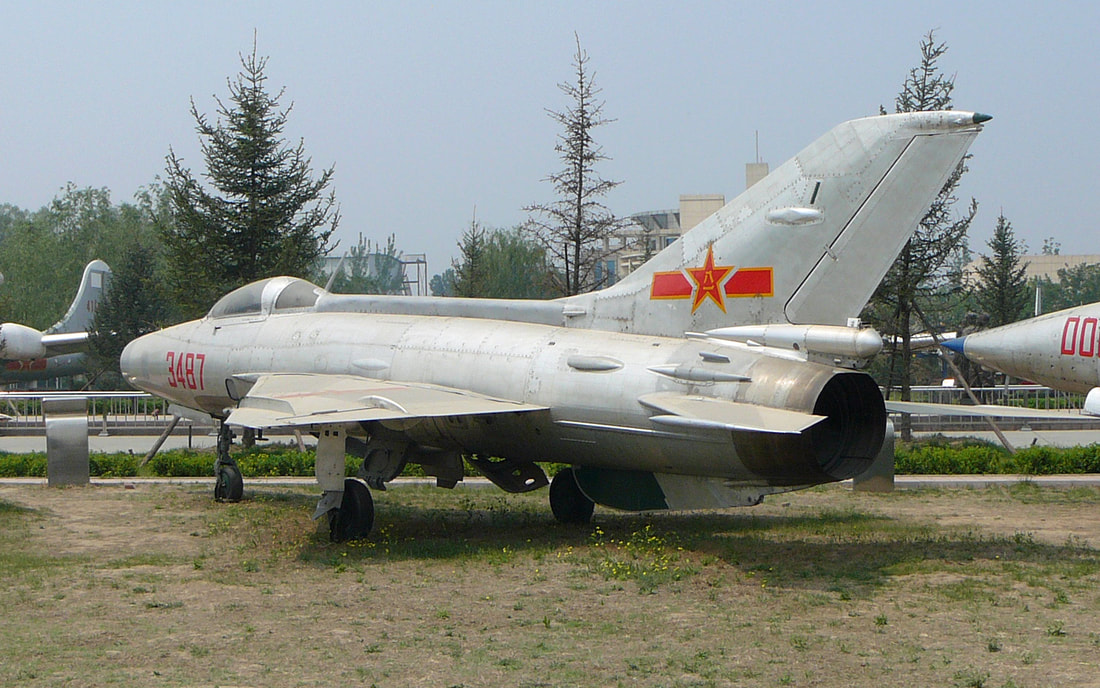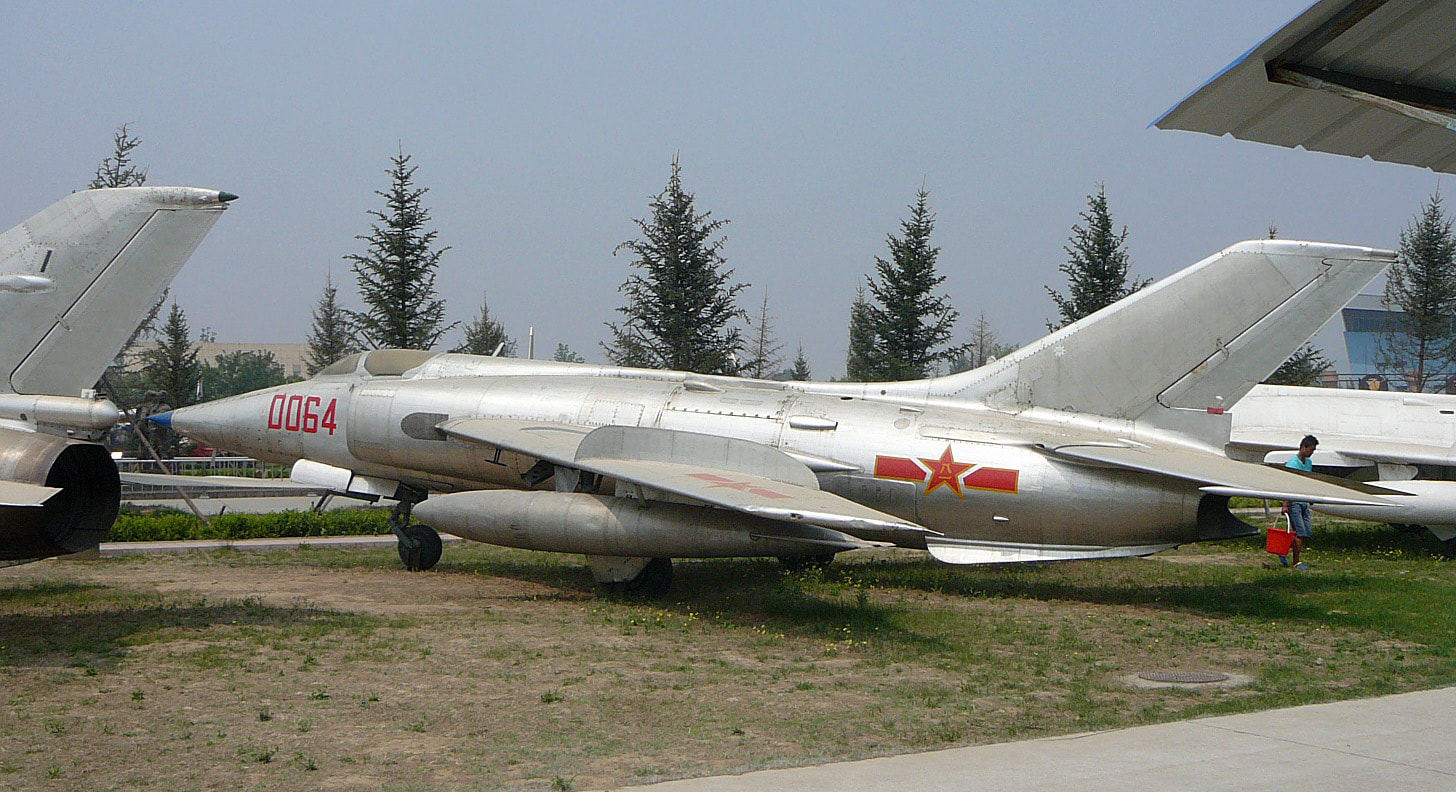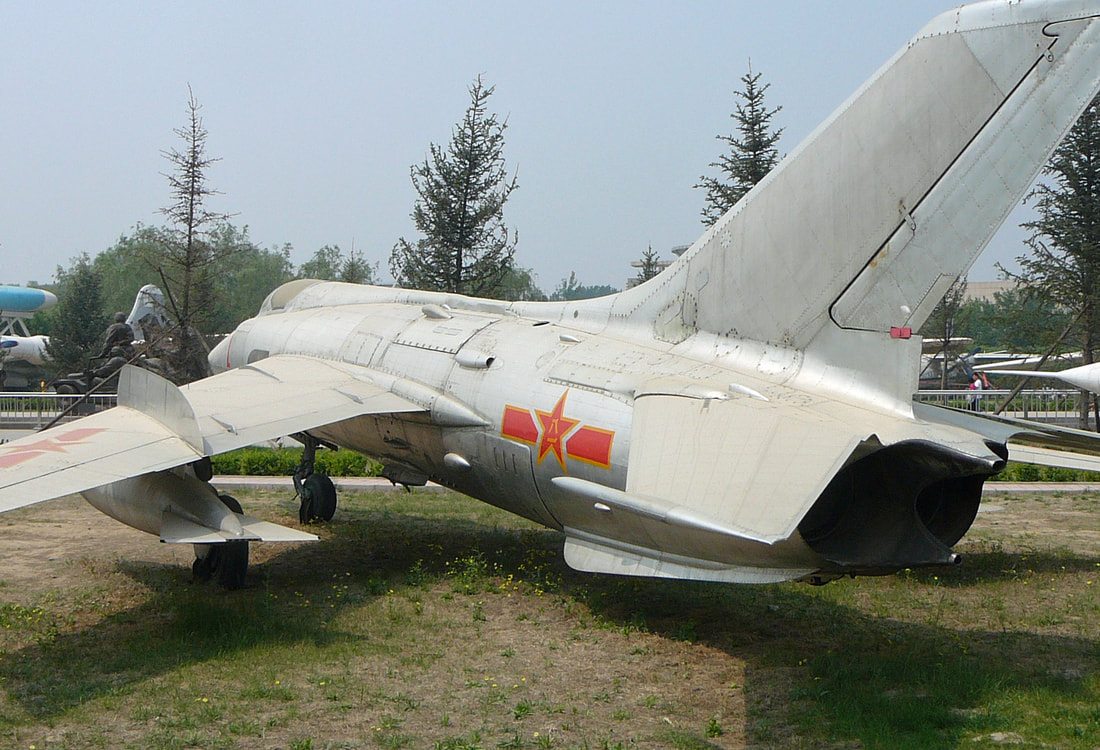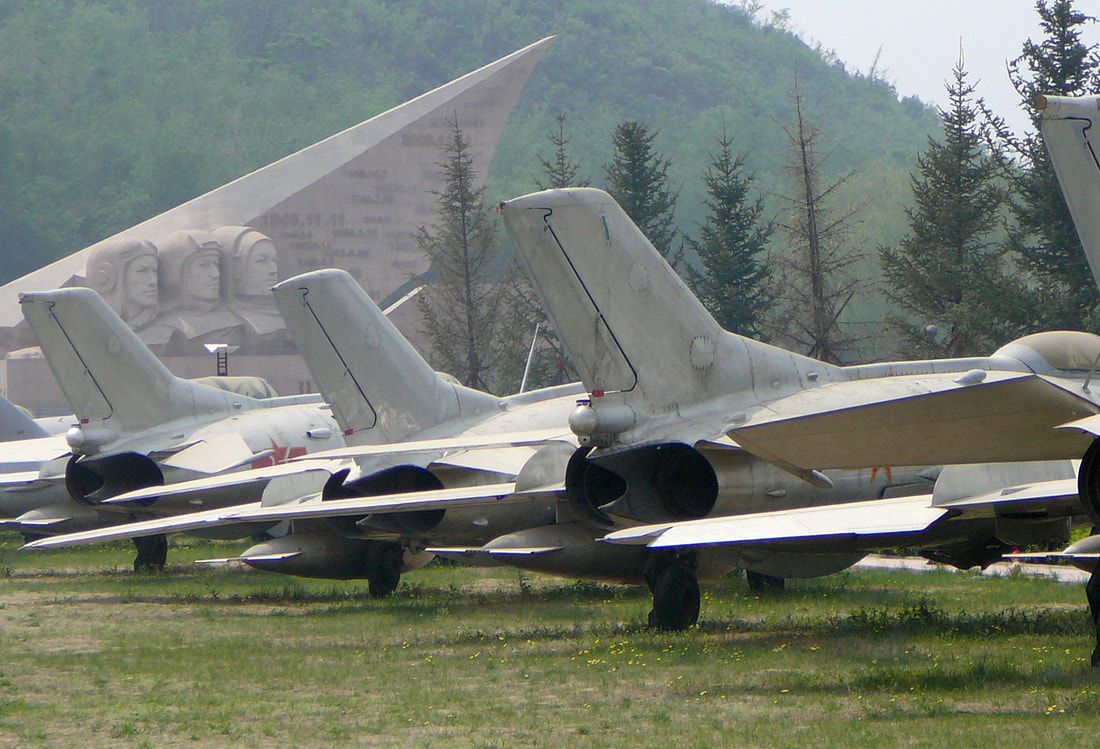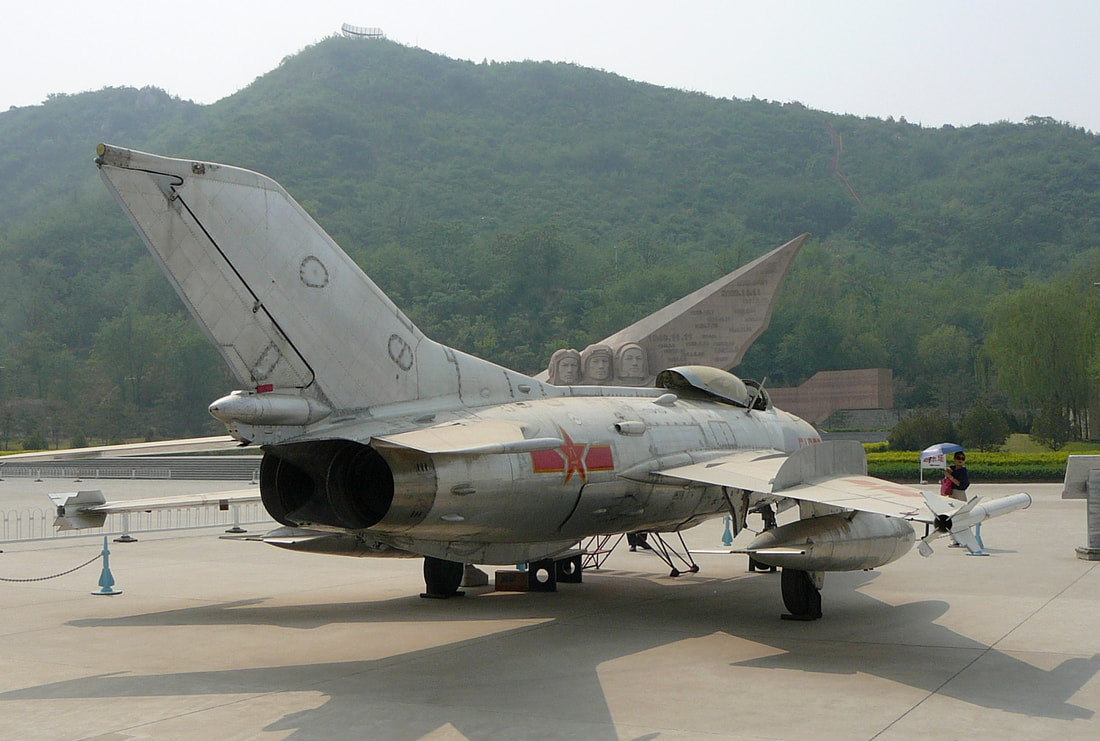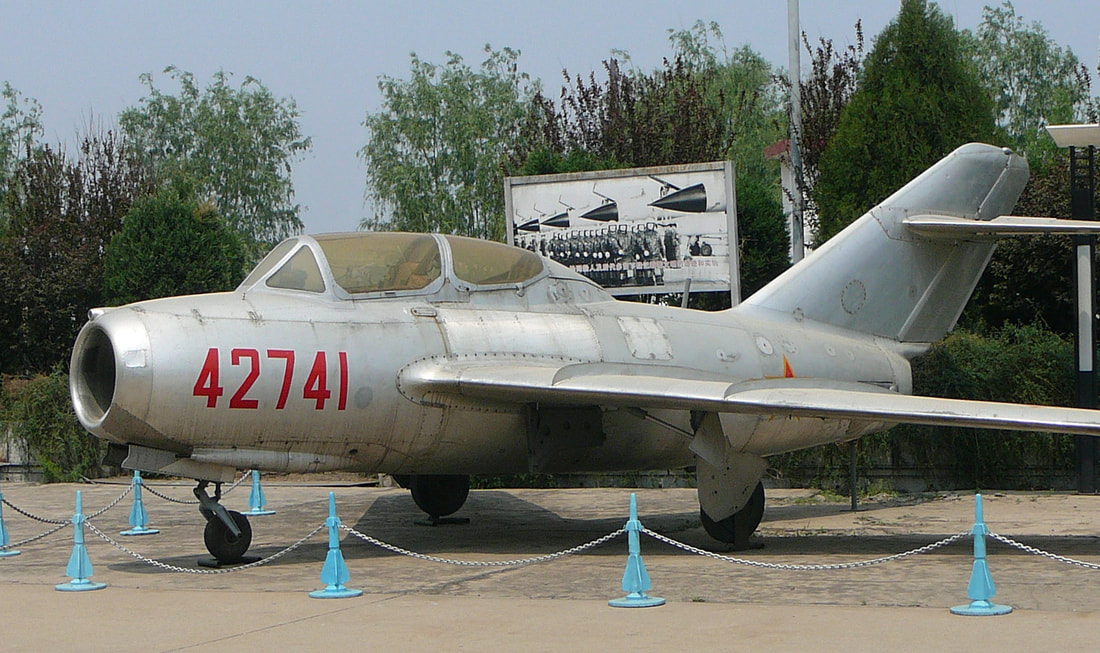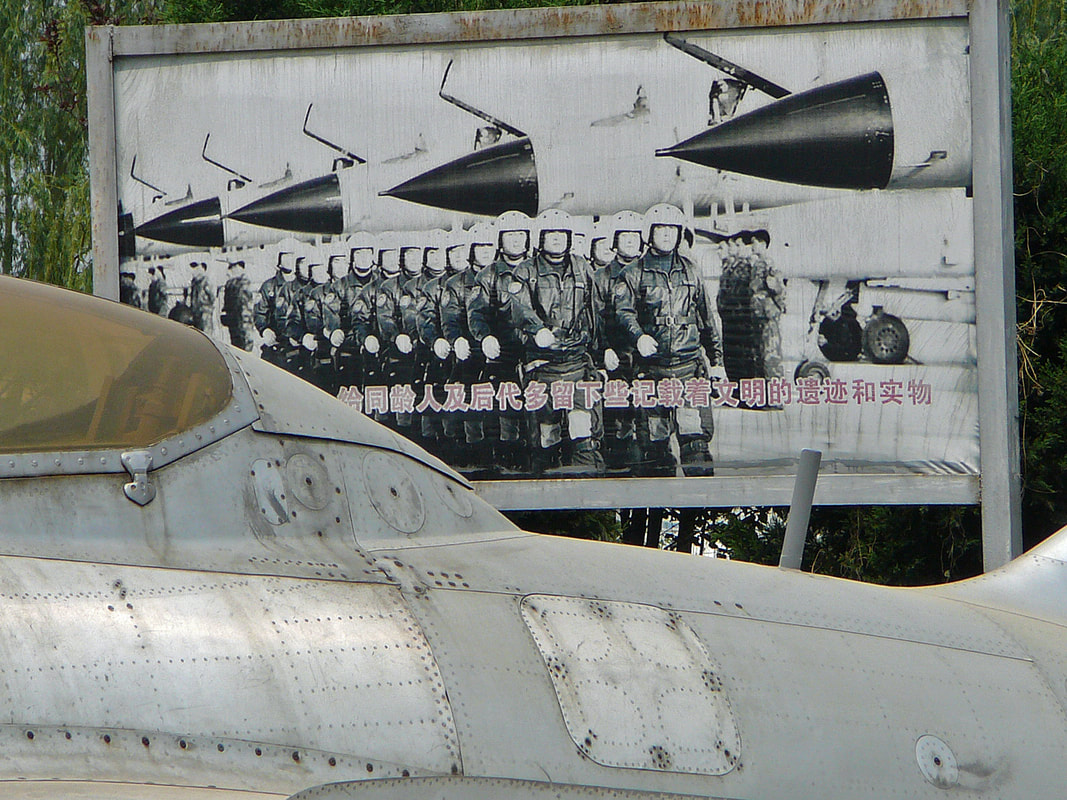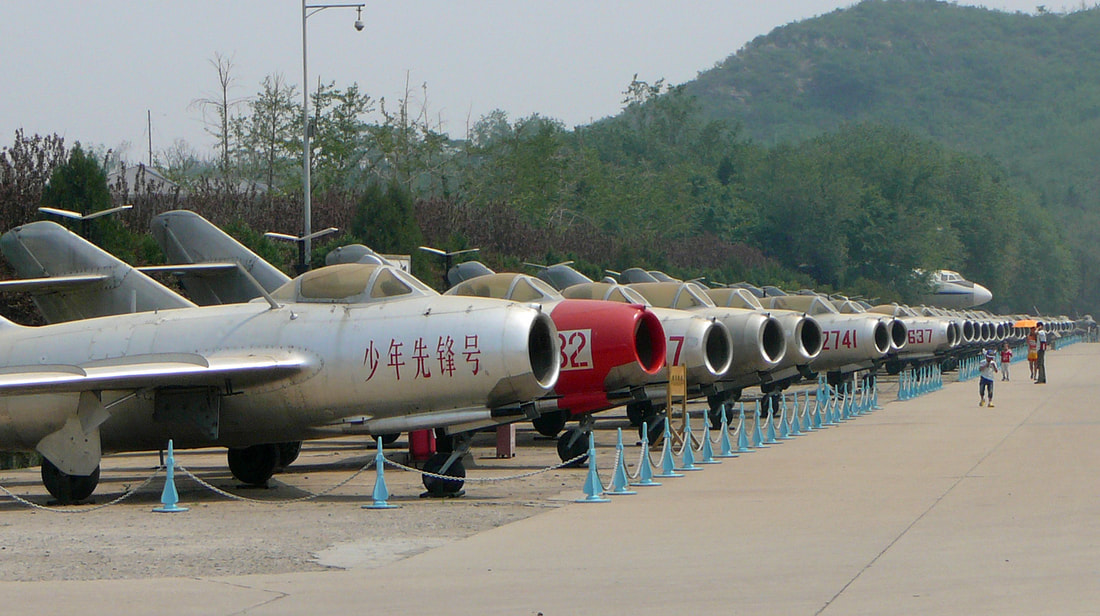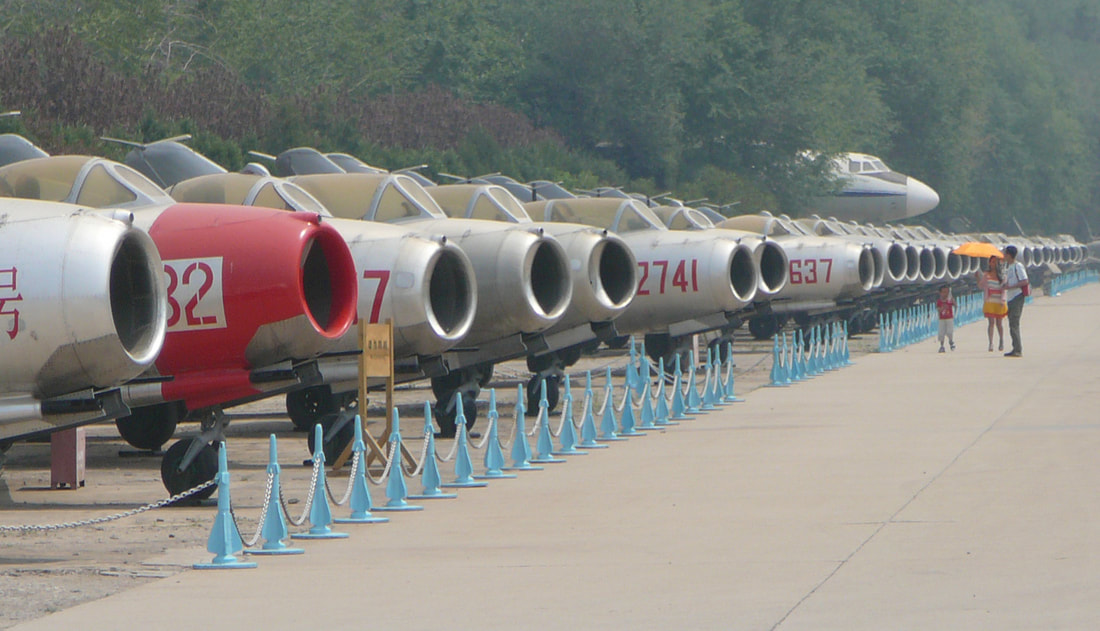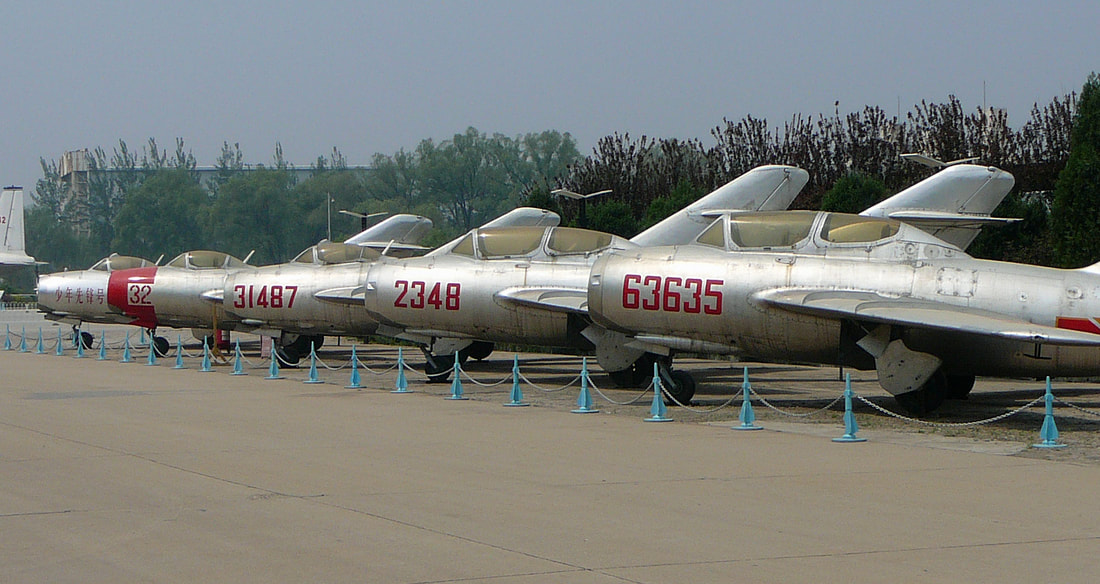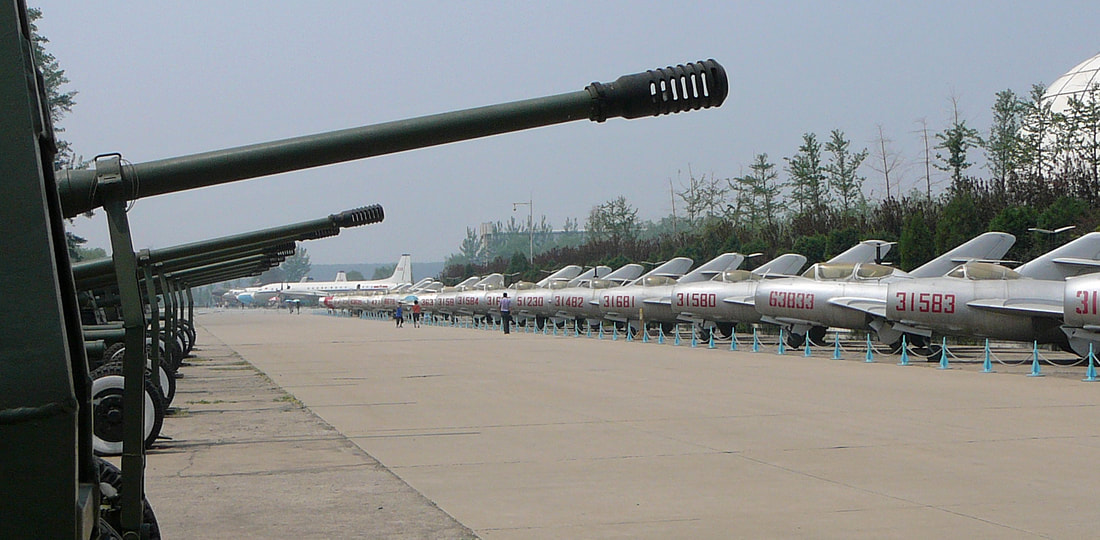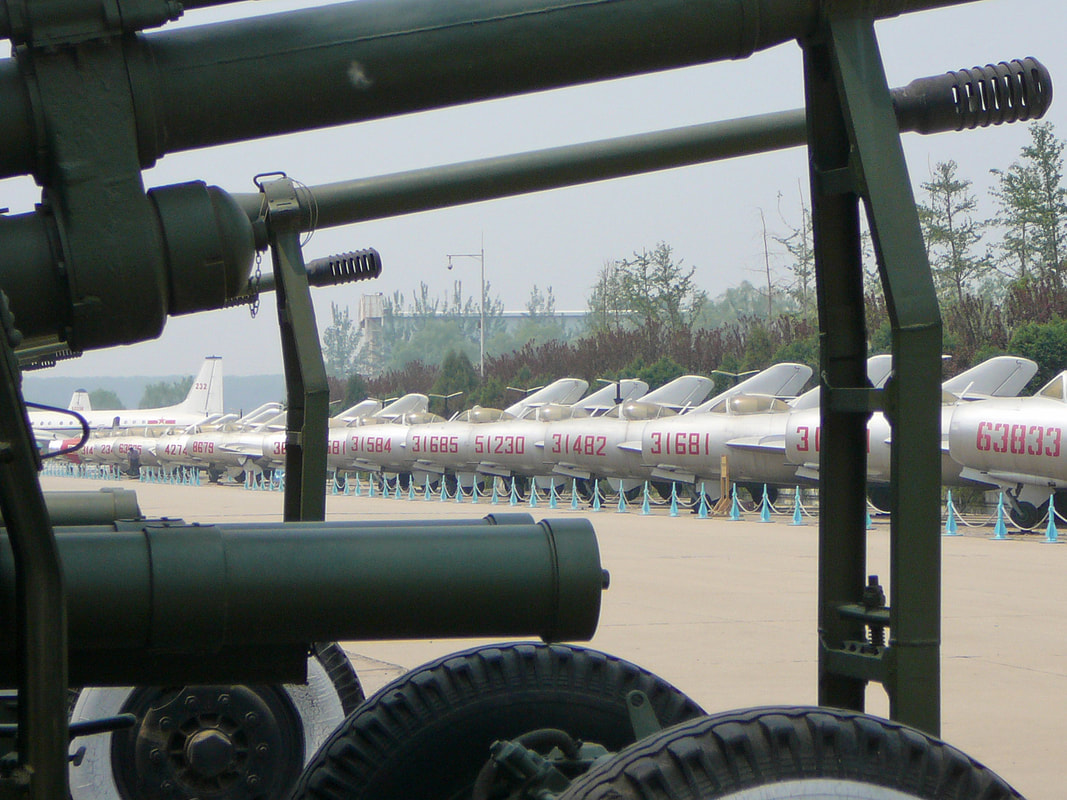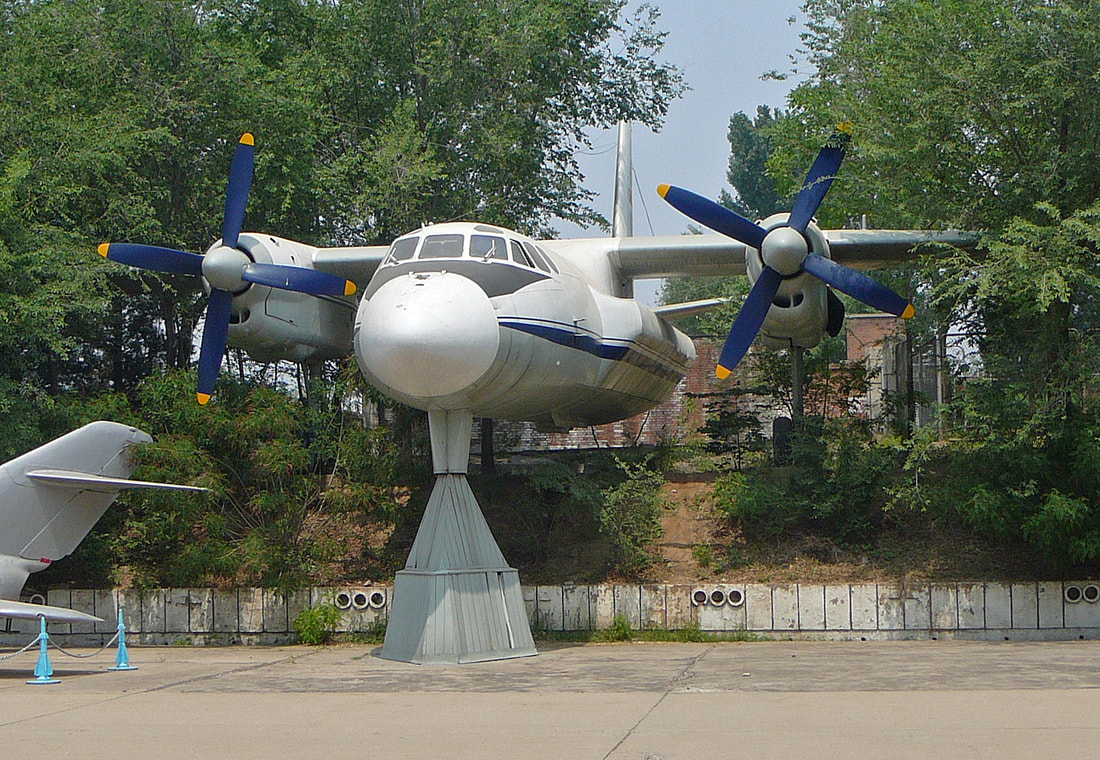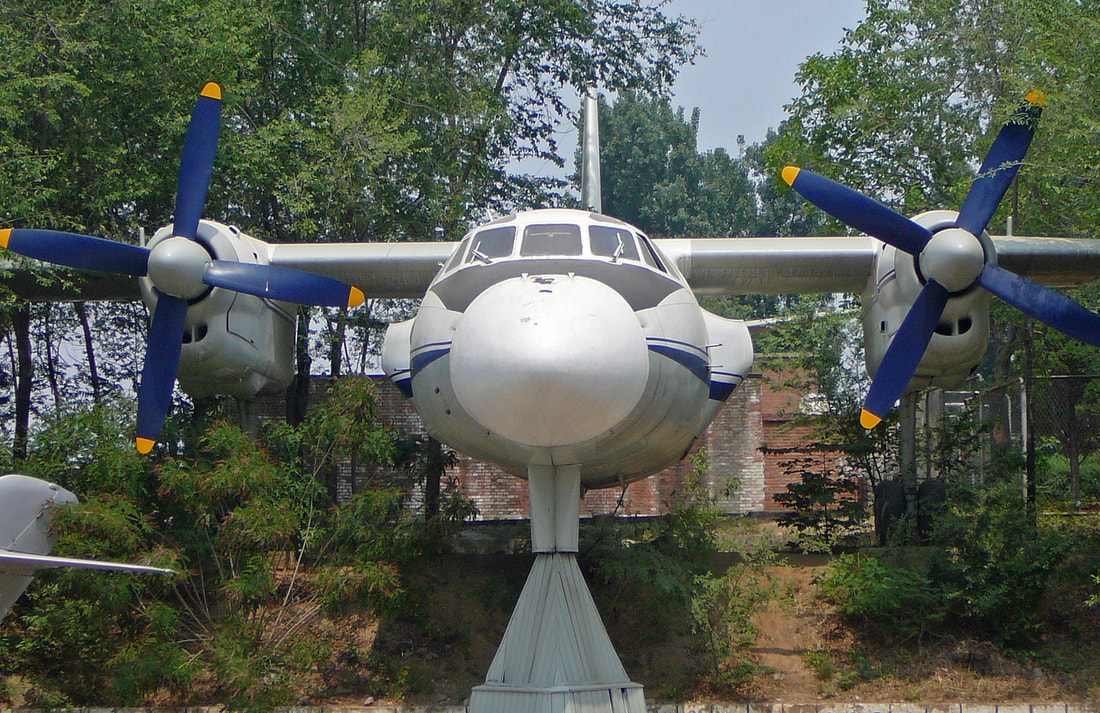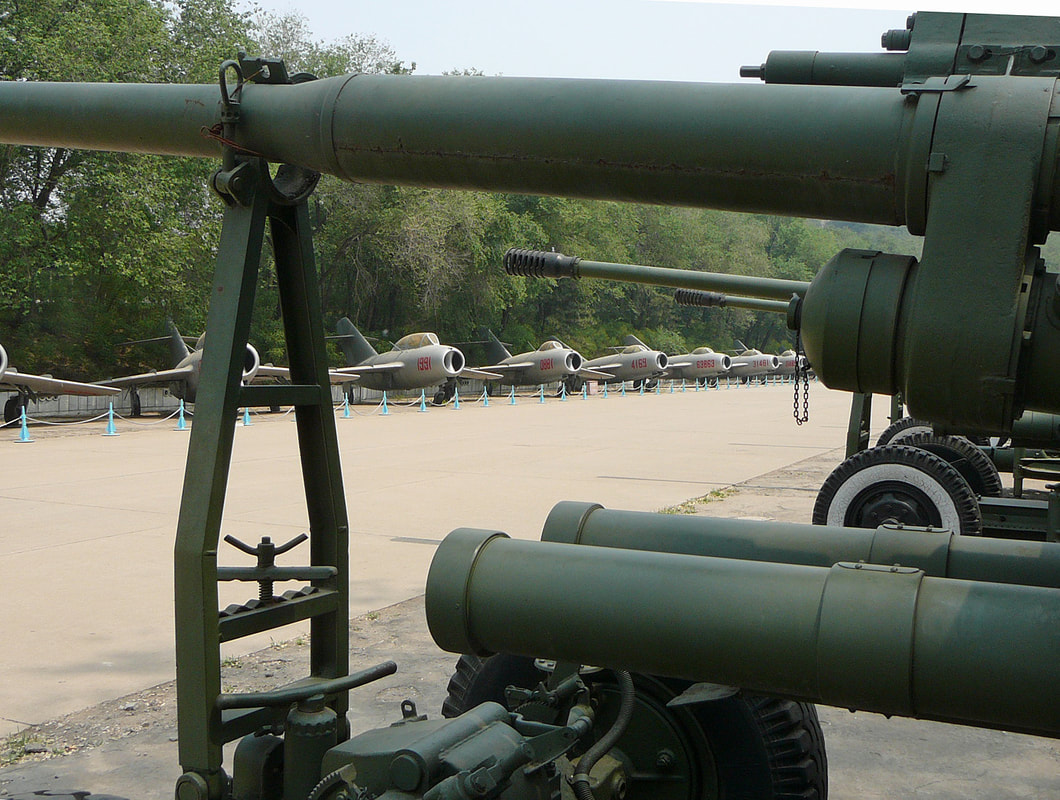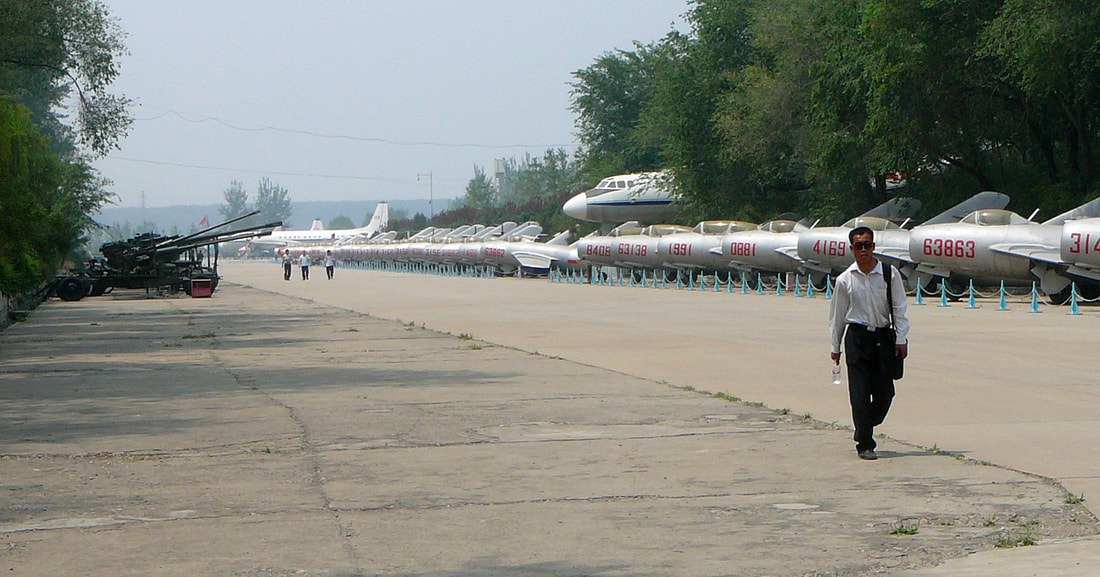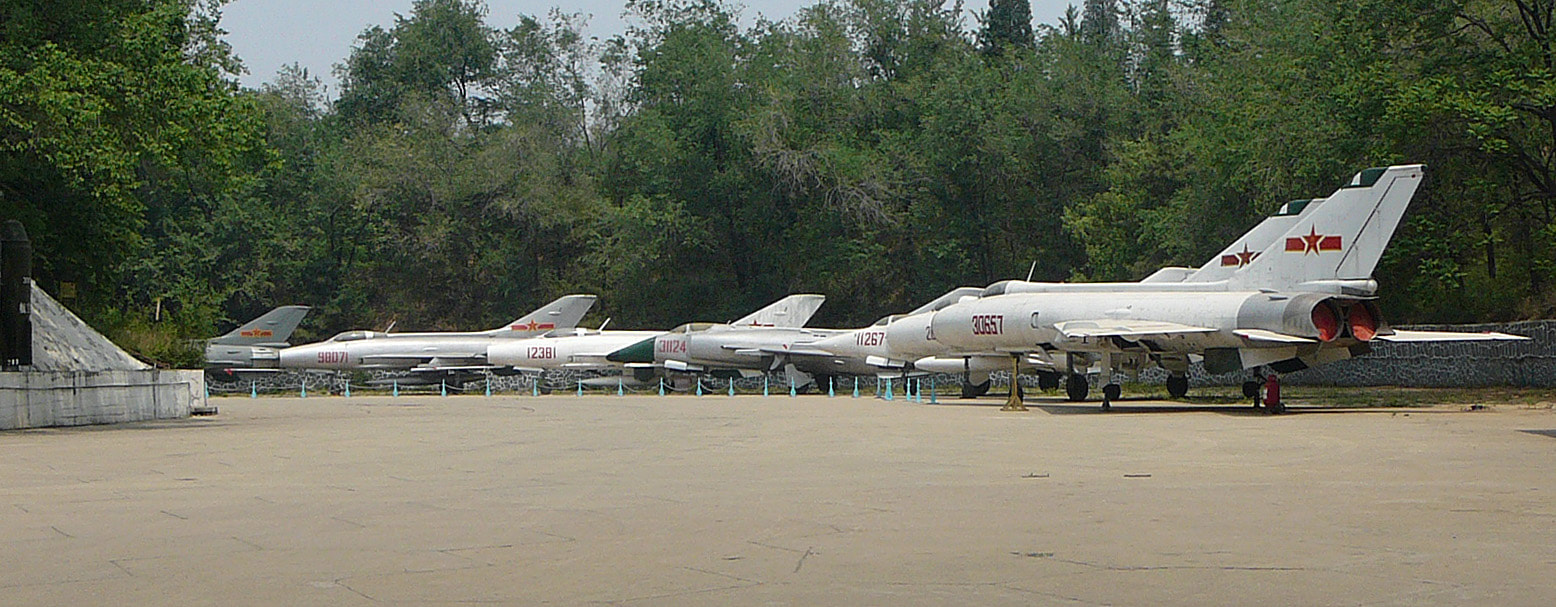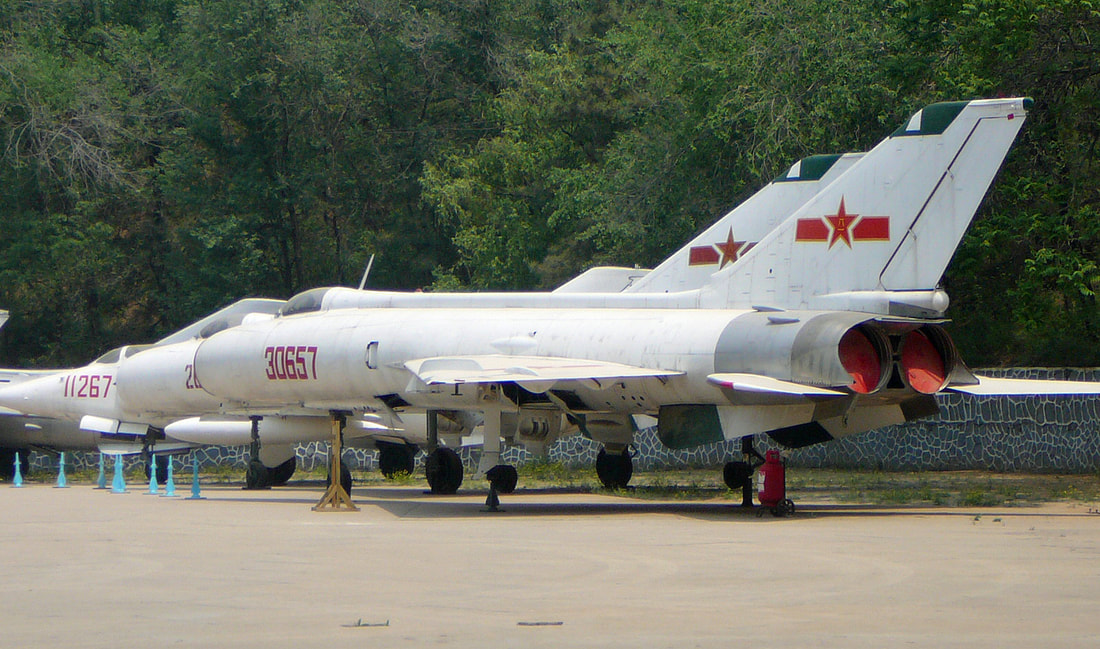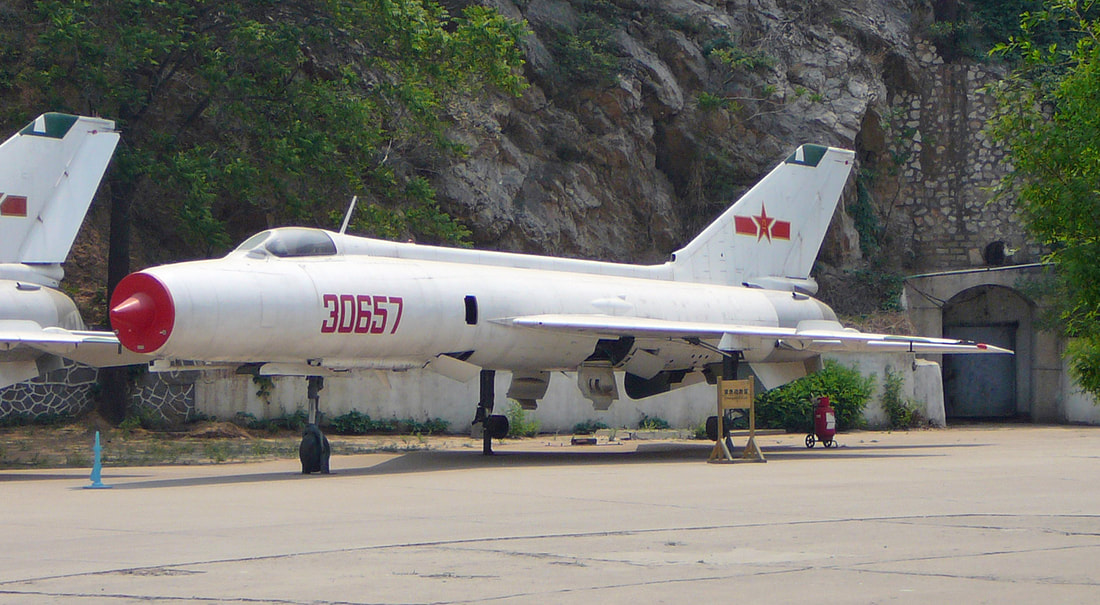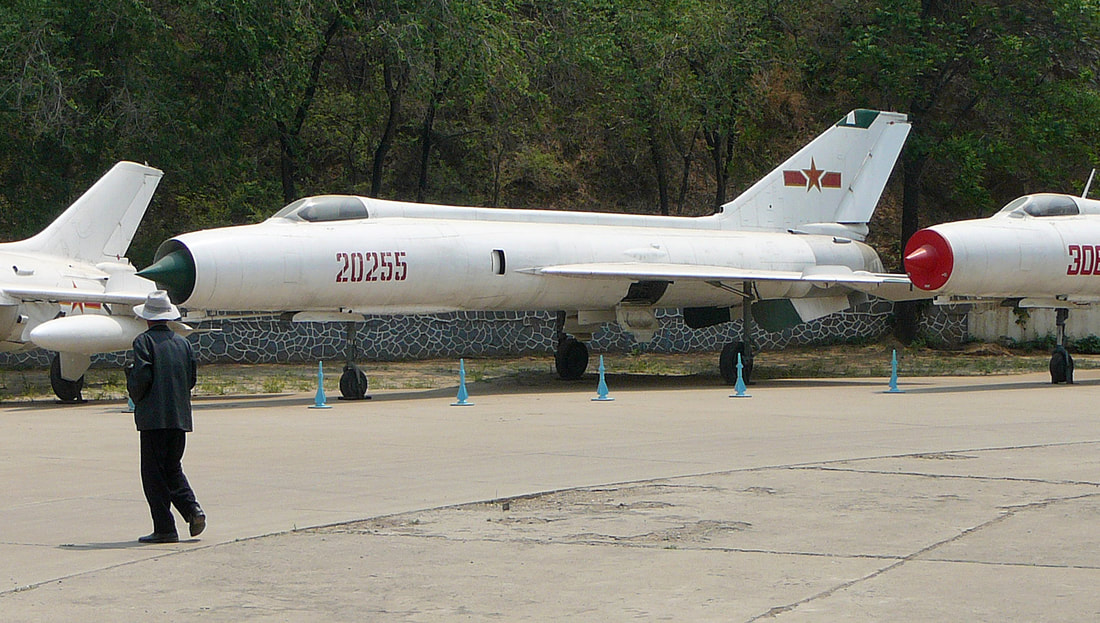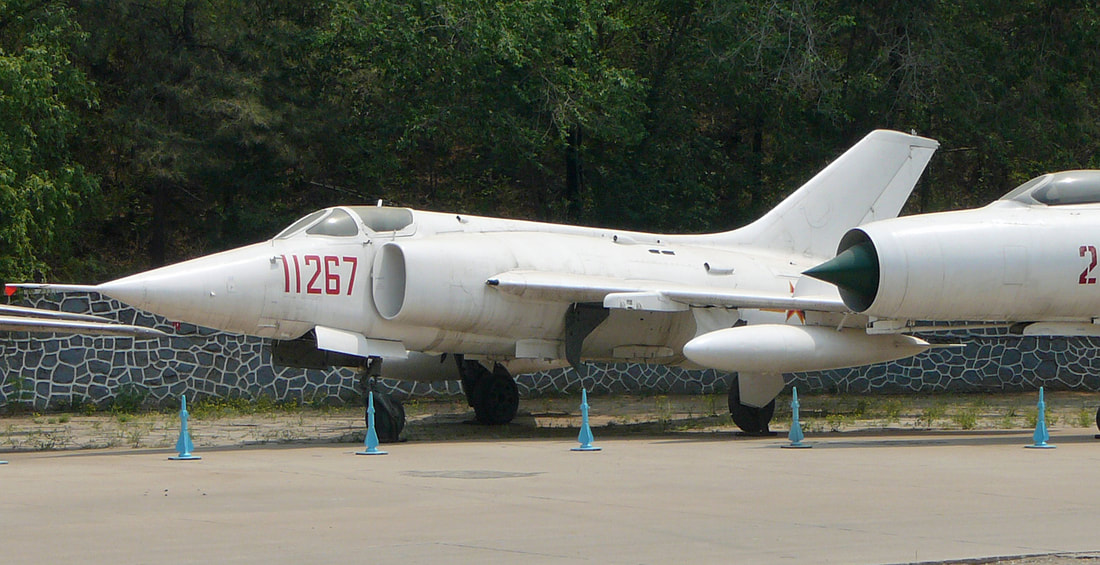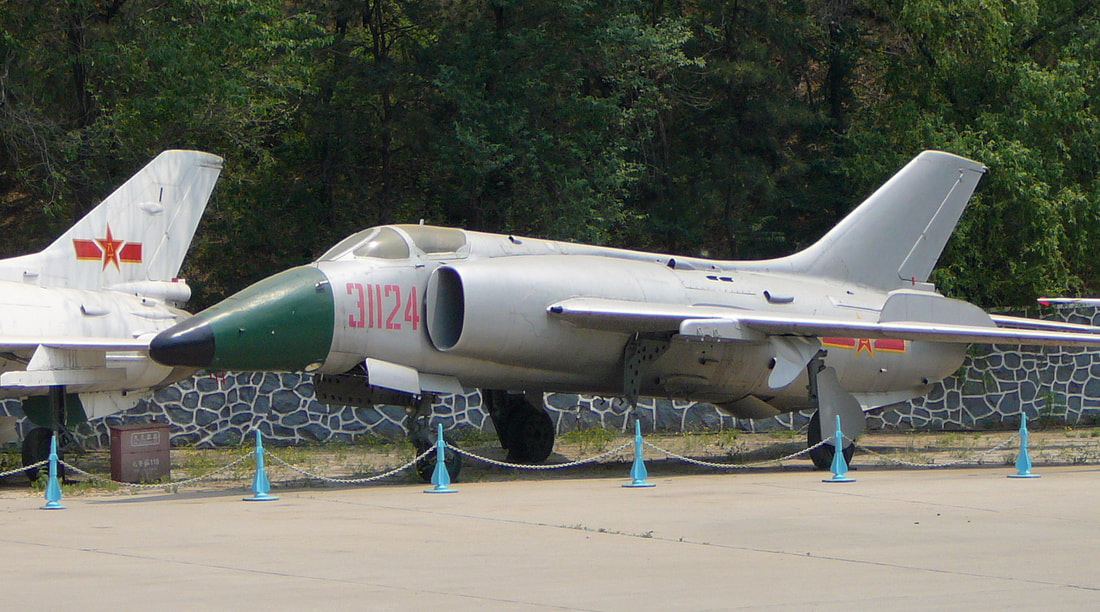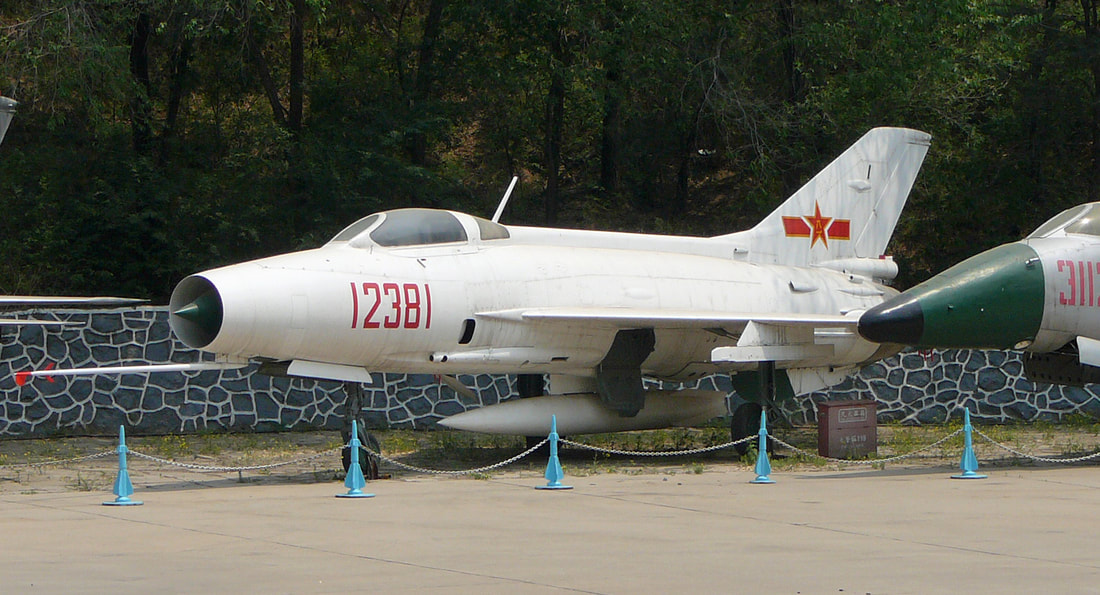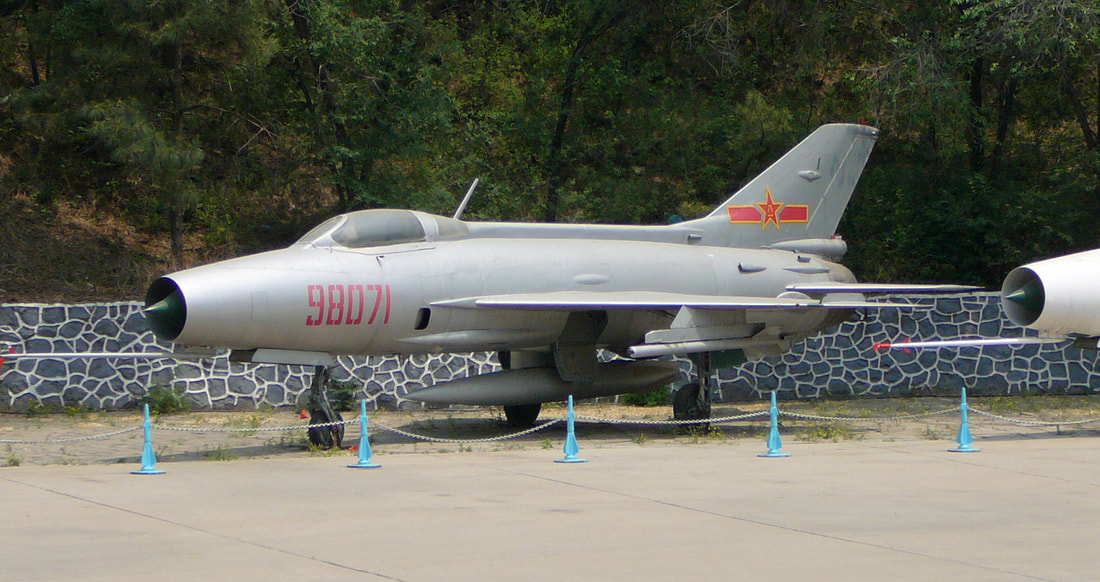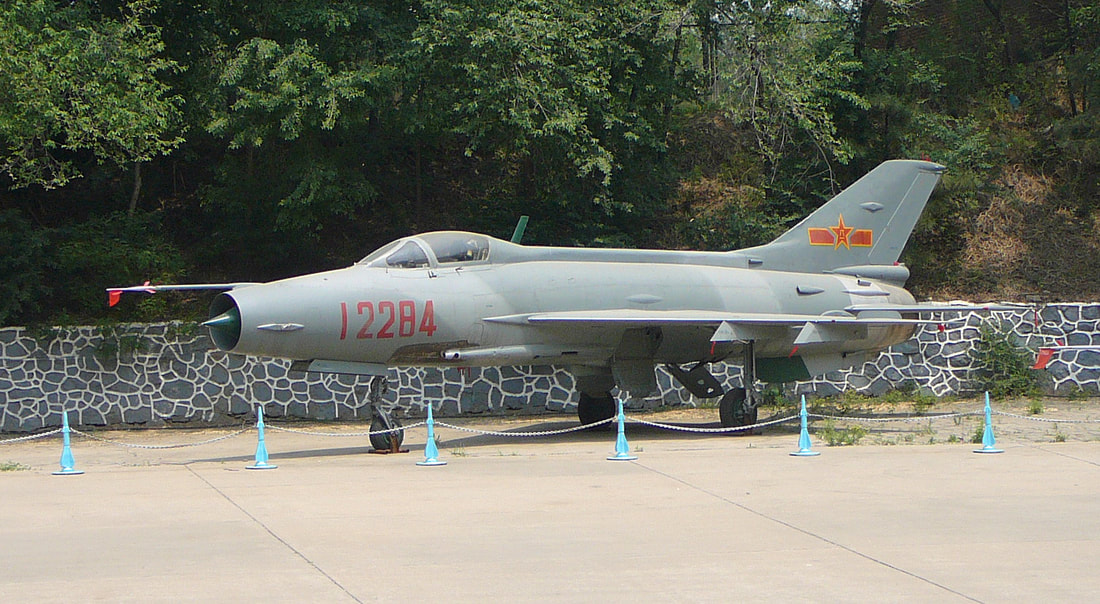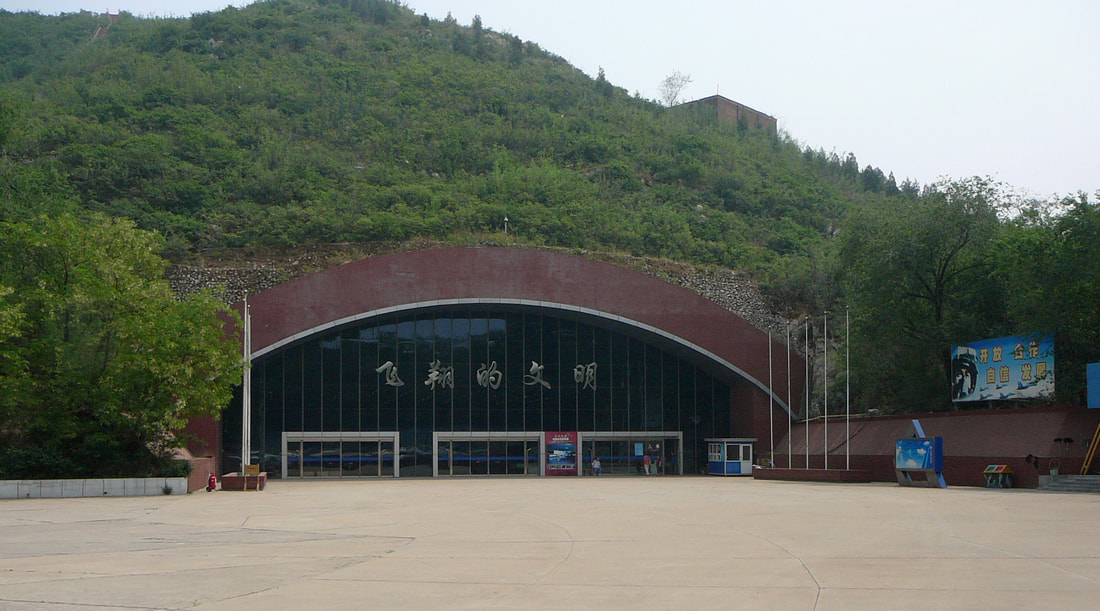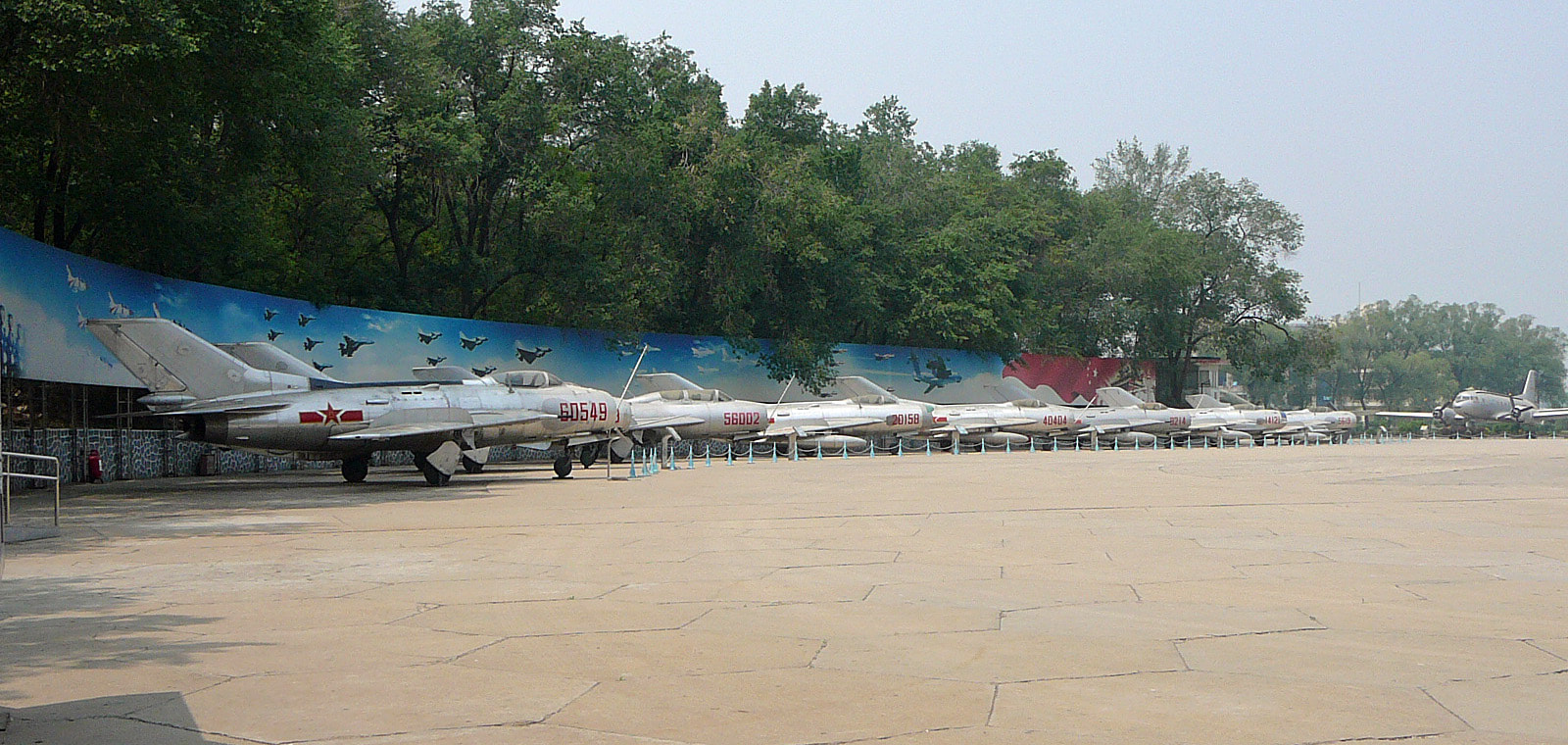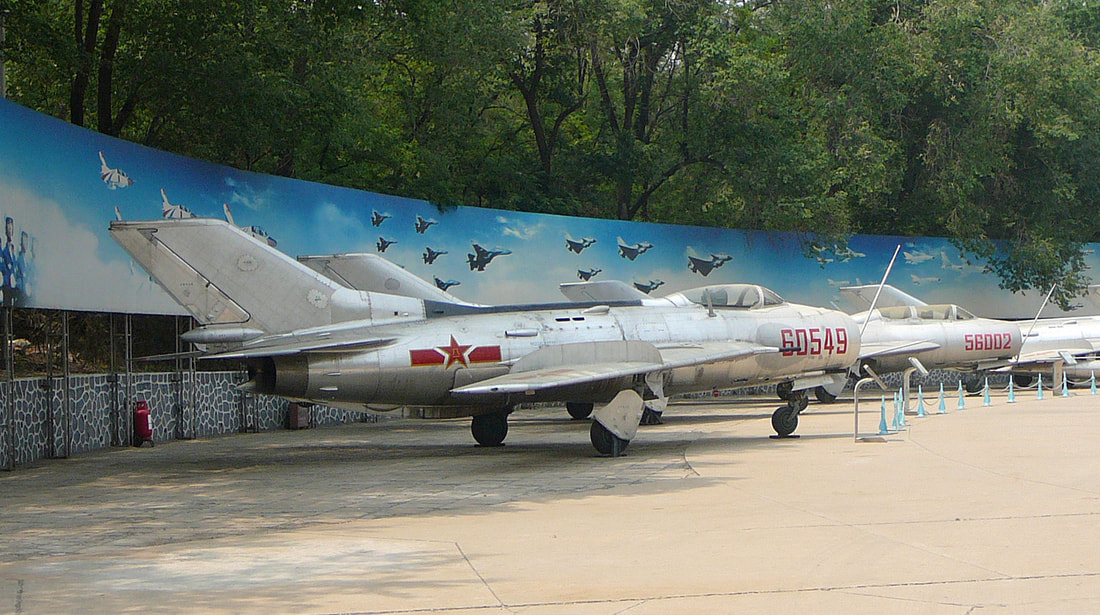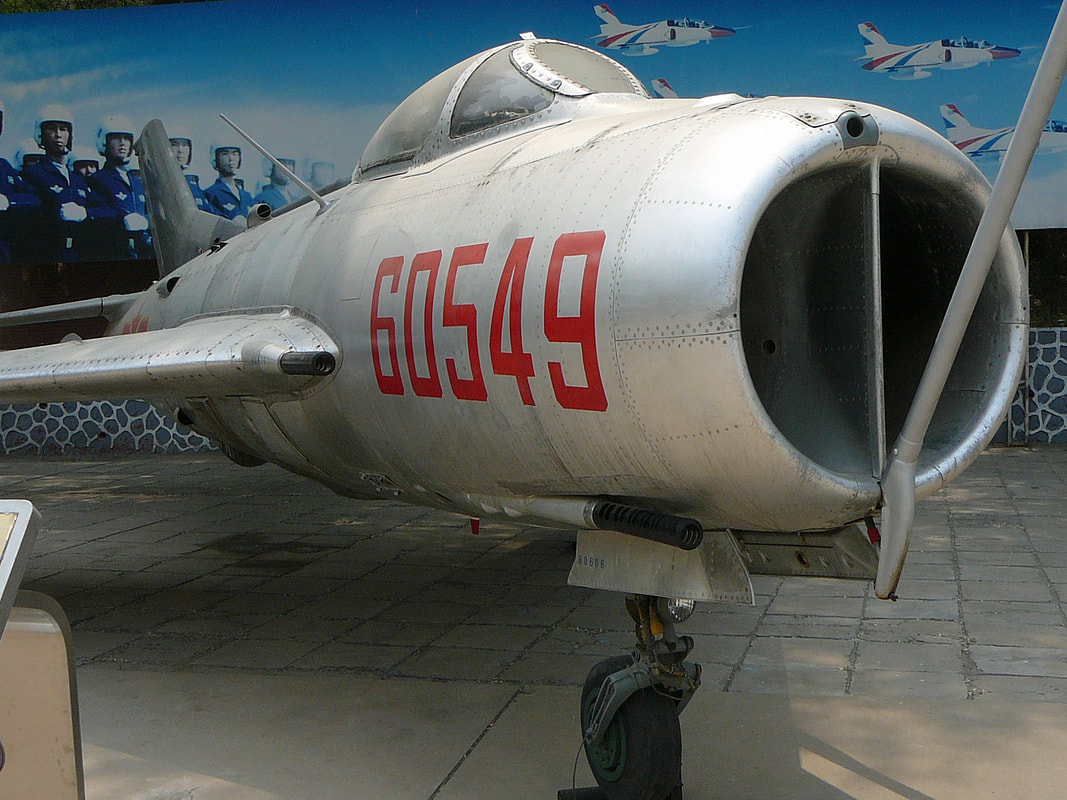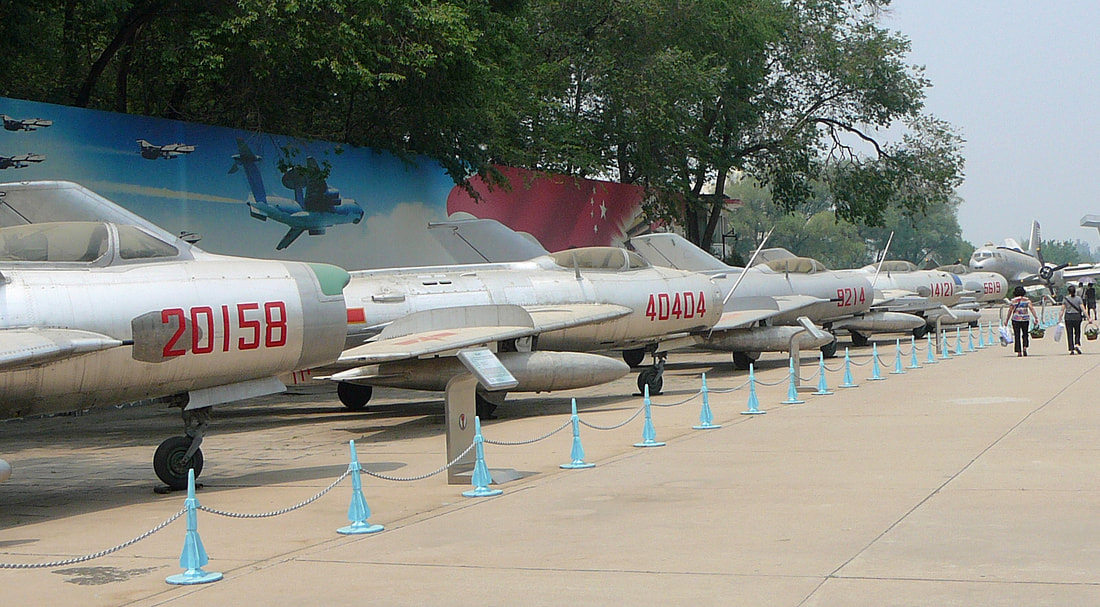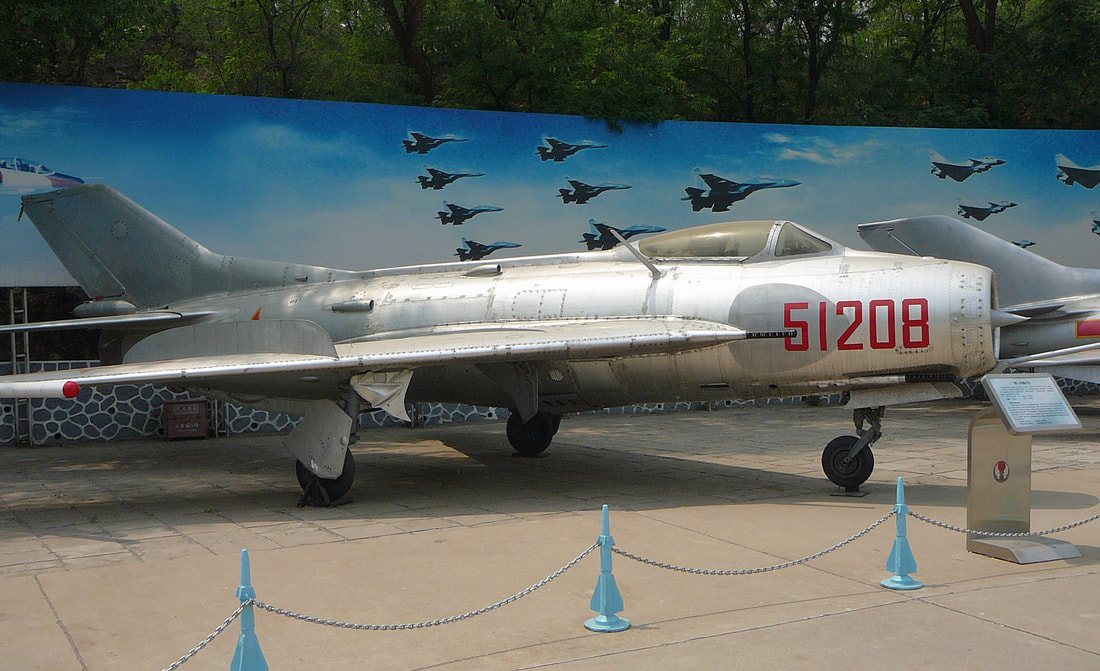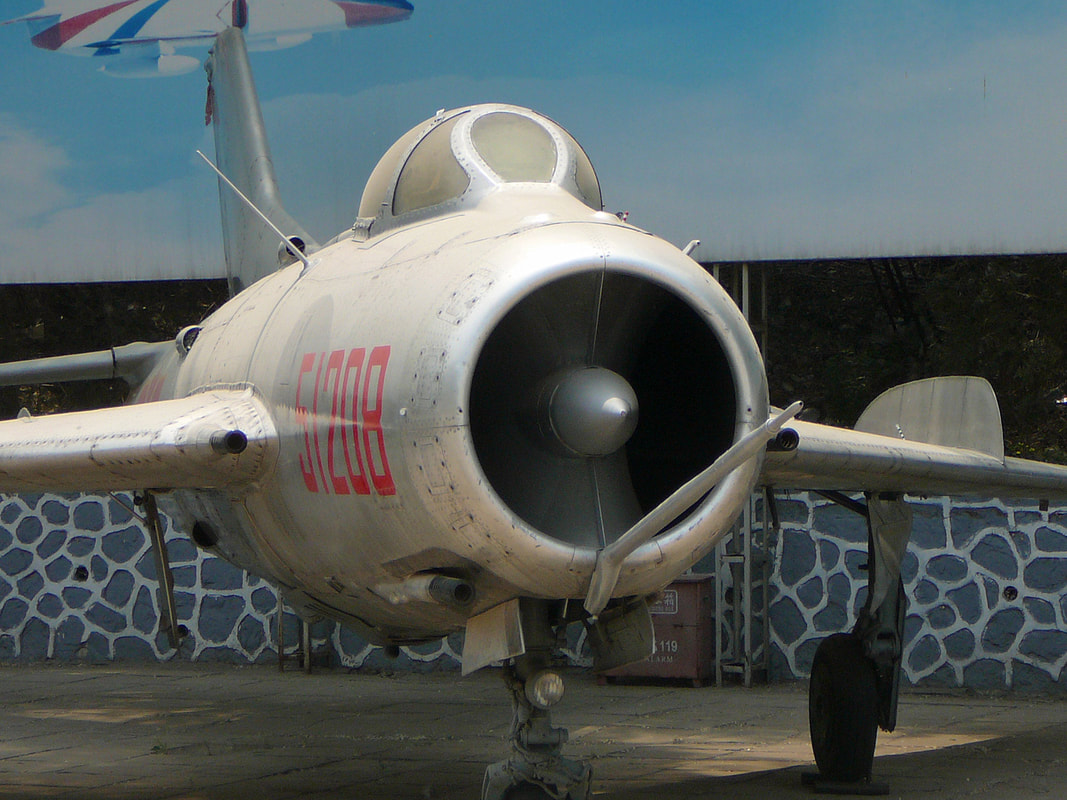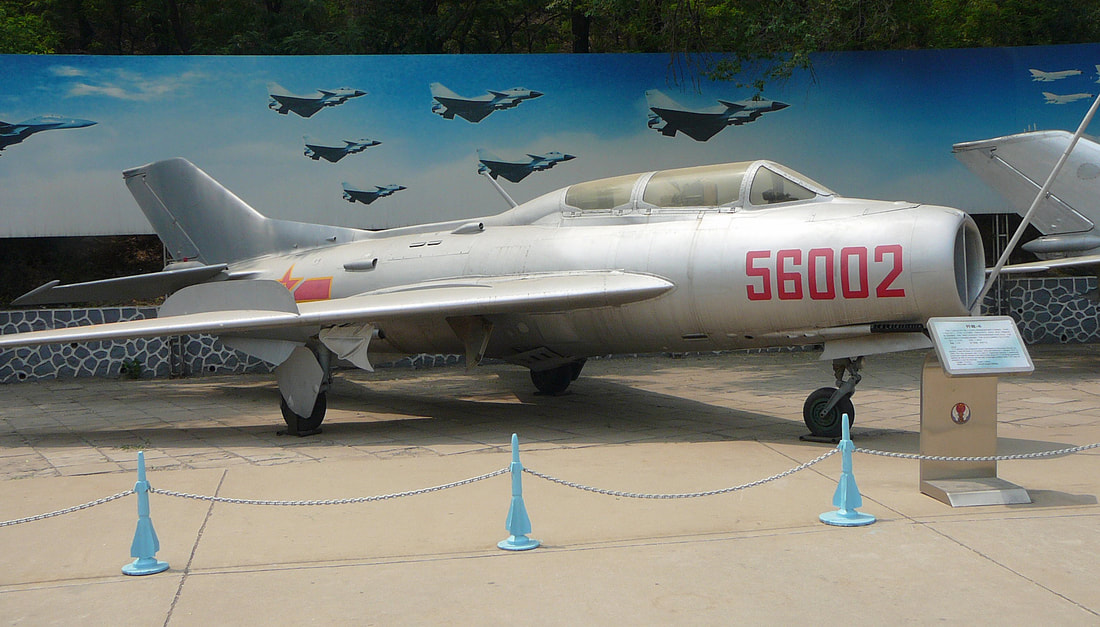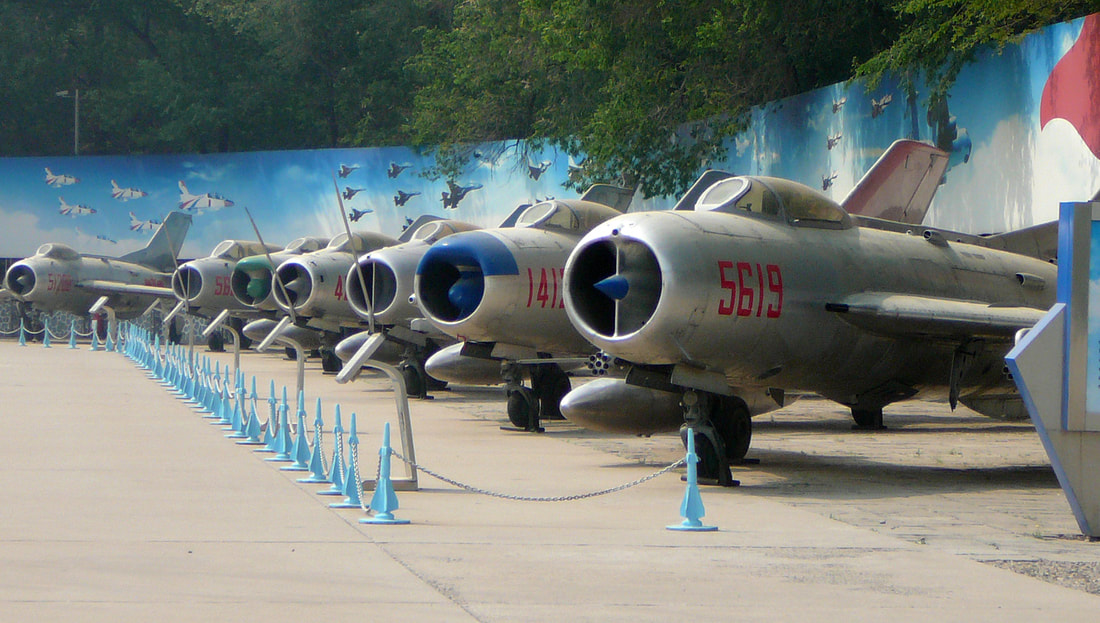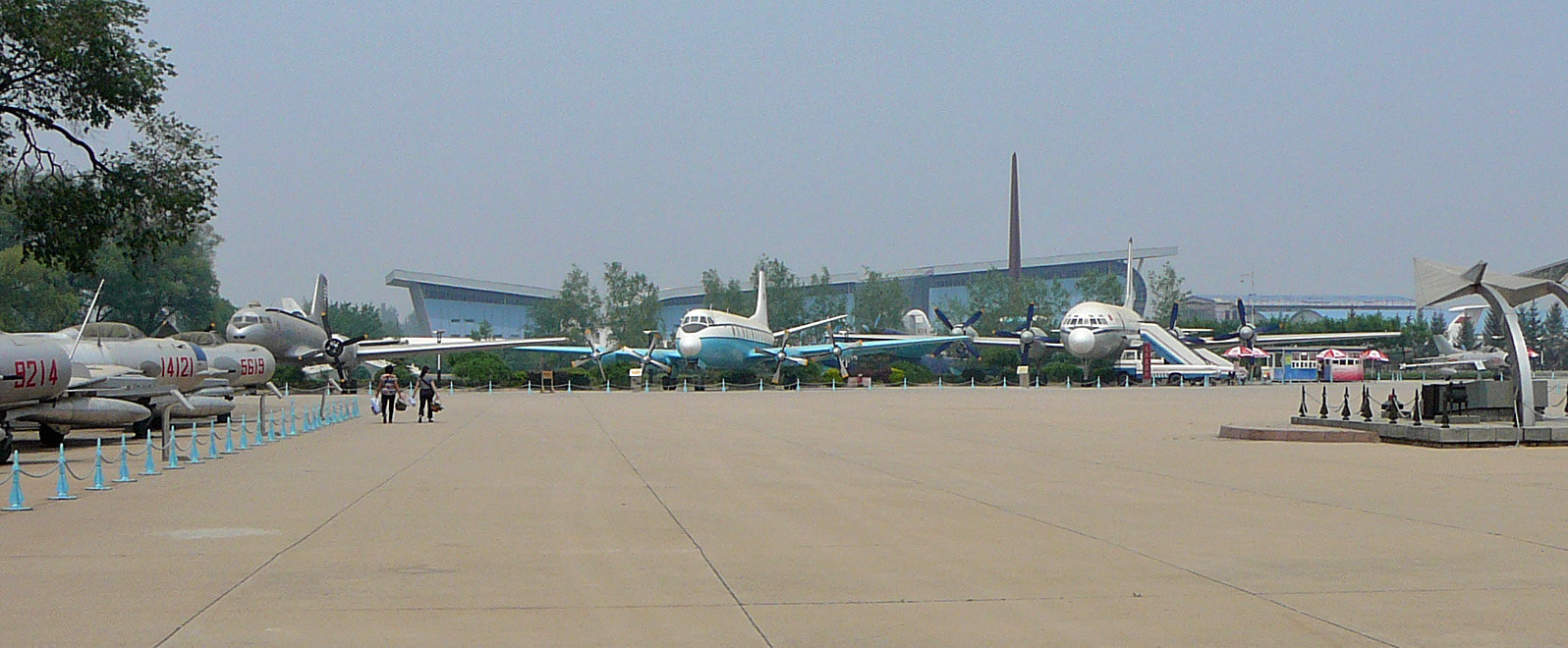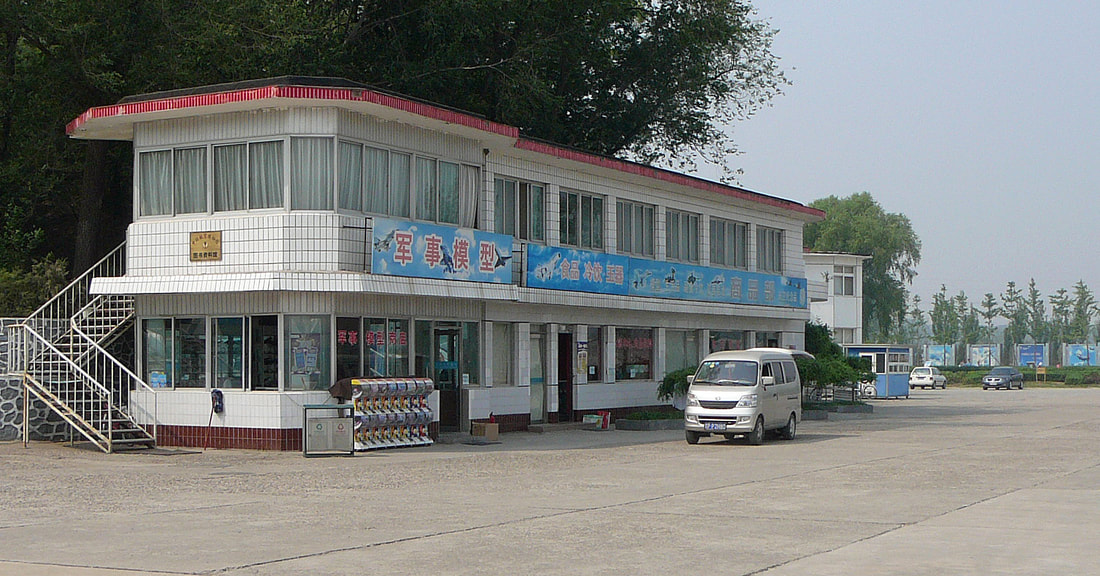Datangshan Aviation Museum continued...
"7272" is an Harbin Z-5. The Harbin Z-5 is a Chinese variant of the Soviet Mil Mi-4 piston powered helicopter. Before its discontinuation from service, it was produced in Harbin, China.
"8673" is an Harbin Z-5. The USSR provided China with Mi-4 blueprints just a few years before the Sino-Soviet split in 1958. Maiden flight was in 1958 and mass production started in the mid-1960s.
"8673" is an Harbin Z-5. China has produced a number of unique variants through this model, and the Z-5 was employed by the PLA, PLAAF and PLANAF in large numbers as reserve forces. A total of 558 Z-5 were built. A few Z-5 helicopters, like this "8673", were modified to carry machine-guns and rocket pods.
A few Z-5 helicopters, like this "8673", were modified to carry machine-guns and rocket pods.
Harbin Z-5 was a piston powered helicopter.
"3685" is an Harbin Z-5.
"3529" is an Harbin Z-5.
"8919" is an Harbin Z-5.
The Harbin/CHDRI Z-6, (Z - Zhishengji - vertical take-off aircraft), is a Chinese helicopter development based on the Harbin Z-5, itself a licence-built / reverse engineered Mil Mi-4. A limited production run was terminated after performance was found to be inferior to its Z-5 progenitor.
Through the Z-5 project the Chinese obtained valuable knowledge and experience in helicopter design and development. The Z-6 is a turboshaft powered development of the piston engine powered Z-5, the first Chinese designed turboshaft helicopter.
"0122" is a Mil Mi-6.
The Mi-6 resulted from a joint civil-military requirement for a very large vertical-lift aircraft, which could be used to add mobility in military operations as well as assist in the exploration and development of the expansive central and eastern regions of the USSR. Flown for the first time on 5 June 1957, the Mi-6 was the first Soviet turboshaft-powered production helicopter.
The R-7 gearbox and rotor head developed for the project have a combined weight of 3200 kg, which is greater than the two turboshaft engines.
Variable-incidence winglets were first mounted on the craft's sides in 1960 to the 30 pre-series units. These wings provide approximately 20% of the lift required during cruise flight.
Variable-incidence winglets were first mounted on the craft's sides in 1960 to the 30 pre-series units. These wings provide approximately 20% of the lift required during cruise flight.
From 1959 to 1972 at least 500 units were built for various general-transport, utility, firefighting and flying-crane duties, the last two sub-types not being fitted with the large fixed wings, which in other versions bear part of the lift in cruising flight and thus enable higher speeds to be attained.
"756" is a Mil Mi-8P of CAAC.
White looks better and when it gets old and dull, it still looks good compared to a dark colored plane. Dark colors fade faster, dull, and when paint flakes off it just looks terrible.
"770" is a Mil Mi-8P of the CAAC.
The Mil Mi-8 has large external fuselage tanks which can be removed easily.
CAAC aircraft livery featured the CAAC logo on a white fuselage.
One of 3 unidentified Mil Mi-8's parked in the helicopter presentation area.
Only 11 Harbin Z-6's were built before the program was cancelled, because the single engine design was deemed unsafe and under-powered.
"762" is a Mil Mi-8T of the CAAC.
Build in 1985, Ilyushin IL-18D "226" now resides at the Datangshan museum next to an HS.121 Trident.
This HS.121 Trident 2E is registrated "50055".
Preserved Trident "50055"; the nosewheel is off-set to accommodate a large avionics bay beneath the flightdeck.
The physical dimensions of most avionics of the period required them to be housed in a large compartment beneath the Trident's flightdeck; the compartment's size was among the factors dictating a distinctive nose undercarriage design, with the nose landing gear offset by 2 ft (61 cm) to the port side and retracting sideways to stow across the D.H.121's longitudinal axis.
One of three Tridents in the Museum - two on display and the front half of a third in a storage area behind this Trident.
Trident 2E at the China Aviation Museum, Beijing.
BEA decided that the Trident was too short-legged for its ever-expanding routes, and that an even longer-ranged version was needed. Hawker Siddeley responded with another upgrade designated Trident 1F. It would have the Spey 511 engines, a 2.8 m fuselage stretch, a gross weight of 132,000 lb (60,000 kg) and up to 128 seats in the original five-abreast configuration. BEA planned to buy 10 1Fs, plus an option for 14 further aircraft. As work continued on the 1F the changes became so widespread that it was renamed the Trident 2E, E for Extended Range. Now powered by newer Spey 512s with 11,930 lbf (53.1 kN) thrust, it also replaced wing leading-edge droop flaps with slats, and extended the span with Küchemann-style tips.[citation needed] It had a gross weight of 142,400 lb (64,600 kg) and a 2,000 miles (3,200 kilometres) range.
BEA bought 15,[51] while two were bought by Cyprus Airways. CAAC, the Chinese national airline, bought 33. The first flight of this version was made on 27 July 1967 and it entered service with BEA in April 1968.
BEA bought 15,[51] while two were bought by Cyprus Airways. CAAC, the Chinese national airline, bought 33. The first flight of this version was made on 27 July 1967 and it entered service with BEA in April 1968.
Underpowered Spey-512's engines were the powerplant of this old Chinese Trident-2E.
"63364" and "63638" are MiG-15UTI's and hanging on by their teeth, hopefully they will stay 'lucky' for some more time.
Antonov An-12BP B-1059 (the 'B' looks like a '8') looks to be marooned in a corner of the former Airbase.
Dumped in the Aeronautical Compound of Datangshan Aviation Museum is this HS.121-2E Trident airframe "B-2202", wearing very faded CAAC marking.
Wings clipped forever. Their carcasses were being used to supply spares for the survivors and now await the cutter’s torch.
I found this mauled Shenyang J-8I "20852", parked in a remote corner of Datangshan.
A camouflaged Lisunov Li-2 and a weather-beaten Nanchang Y-5 ('Chinese' Antonov An-2), lurks in the background.
A nice line-up of Chinese hardware. One can see the Shenyang J-8, Nanchang Q-5 and the Shenyang J-5.
"30650" is a Shenyang J-8. The Shenyang J-8; (NATO reporting name: Finback) is a high-speed, high-altitude Chinese-built single-seat interceptor fighter aircraft.
"3487" is a Chengdu J-7I. The Chengdu J-7; ( third generation export version F-7; NATO reporting name: Fishcan) is a People's Republic of China license-built version of the Soviet Mikoyan-Gurevich MiG-21. Though production ceased in 2013, it continues to serve, mostly as an interceptor, in several air forces, including the People's Liberation Army Air Force.
"0064" is a Nanchang Q-5. The Nanchang Q-5; NATO reporting name: Fantan), also known as the A-5 in its export versions, is a Chinese-built jet ground-attack aircraft capable of supersonic speed in level flight, which is similar to its predecessor Soviet MiG-19. However, the aircraft is predominantly flown at subsonic speeds due to its primary role being close air support.
Note; The extreme large wing fences, on this Nanchang Q-5. Wing fences are also known as boundary layer fences and potential fences are fixed aerodynamic devices attached to aircraft wings. Often seen on swept-wing aircraft, wing fences are flat plates fixed to the upper surfaces parallel to the airflow, typically wrapping around the leading edge. By obstructing span-wise airflow along the wing, they prevent the entire wing from stalling at once, as opposed to wingtip devices, which increase aerodynamic efficiency by seeking to recover wing vortex energy.
Nice line-up of the tail-ends of a couple of Shenyang J-6's.
A Shenyang J-6 with her enormous wing fences clearly visible.
The Shenyang J-5, like this "42741" (NATO reporting name Fresco) is a Chinese-built single-seat jet interceptor and fighter aircraft derived from the Soviet Mikoyan-Gurevich MiG-17.
The MiG-17 was license-built in China and Poland into the 1960s. The People's Liberation Army Air Force (PLAAF) obtained a number of Soviet-built MiG-17 Fresco-A day fighters, designated J-4 in the early 1950s. To introduce modern production methods to Chinese industry the PLAAF obtained plans for the MiG-17F Fresco-C day fighter in 1955, along with two completed pattern aircraft, 15 knockdown kits, and parts for ten aircraft. The first Chinese-built MiG-17F, (serialed Zhong 0101), produced by the Shenyang factory, performed its initial flight on 19 July 1956.
The first aircraft in the long row is a North-Korean MiG-15.
An endless row of MiG-15's and Shenyang J-5's.
MiG-15's and Shenyang J-5's gleaming in the sun.
And here's another throwback in-time photo.
Vintage anti-aircraft guns form a fitting frame for these classic jet-fighters lined-up at Datangshan in 2012.
"50954" is a highly modified Antonov An-24B.
Parked between the trees, behind the MiG line-up, is Antonov An-24B "50954". She sports large bulges along her fuselage sides.
This stunning photograph help capture the essence of the lost age of the early russian and chinese fighter jets.
Soft spring light glints off these classic Chinese jet-fighters.
"30657" is a Shenyang J8-I.
The last jet-fighter before you enter the tunnel complex.
The Chinese Aviation Museum, sometimes referred to as the China Aviation Museum and the Datangshan Aviation Museum (due to its location adjacent to the mountain of the same name), is an aviation museum in Changping District, Beijing, China. The museum was first opened to the public on 11 November 1989, to celebrate the 40th anniversary of the founding of the People's Liberation Army Air Force.
The museum is located 40 km (25 mi) north of Beijing city. Part of the museum is located inside a cave in the side of Datangshan Mountain. The cavern was originally part of the tunnels and underground bunker system of Shahezhen Airbase, and is 586 metres (1,905 ft) long by 11 metres (36 ft) high by 40 metres (130 ft) wide. The road leading to the museum is actually also used as a taxiway between the base and bunker system.
The museum is located 40 km (25 mi) north of Beijing city. Part of the museum is located inside a cave in the side of Datangshan Mountain. The cavern was originally part of the tunnels and underground bunker system of Shahezhen Airbase, and is 586 metres (1,905 ft) long by 11 metres (36 ft) high by 40 metres (130 ft) wide. The road leading to the museum is actually also used as a taxiway between the base and bunker system.
"20255" is a Shenyang J8-I.
With a midday temperature of 35 degrees centigrade, Chinese Air Force Nanchang Q-5II "11267", is seen here resting forever at Datangshan Aviation Museum.
"31124" is the unique Nanchang Q-5B/A-5B torpedo attacker.
"12381" is a Chengdu J-7. The Chengdu J-7; third generation export version F-7; (NATO reporting name: Fishcan) is a People's Republic of China license-built version of the Soviet Mikoyan-Gurevich MiG-21. Though production ceased in 2013, it continues to serve, mostly as an interceptor, in several air forces, including the People's Liberation Army Air Force.
"98071" is a MiG-21F-13.
Preserved at the Datangshan, China. "12284", a Chengdu J-7I, looks like to be in engine running condition.
70+ airplanes are displayed in the tunnel of the Datangshan mountain. The museum is located 40 km (25 mi) north of Beijing city. Part of the museum is located inside a cave in the side of Datangshan Mountain. The cavern was originally part of the tunnels and underground bunker system of Shahezhen Airbase, and is 586 metres (1,905 ft) long by 11 metres (36 ft) high by 40 metres (130 ft) wide.
Looks like a Museum ramp! - Crystal clear image on a sticky day in May 2012.
"60549", a Shenyang J-6, sitting pretty at Datangshan in May 2012.
This natural metal Shenyang J-6 is preserved at Datangshan.
Mid-day sunshine glints off the polished aluminum of these classic Chinese fighter-jets.
Cleared skin Shenyang J-6III "51208".
This “III” model, without a lick of paint on its dull fuselage, grimy hide other than the registration, "51208".
Shenyang JJ-6, "56002", warms its natural metal finish in the strong Chinese sunshine.
The Shenyang J-6's were the Chinese Air Force workhorses.
In the background, three aviation classics, on a sweltering Datangshan tarmac, in May 2012.
Pfff.... let have an Chinese Coke and a snack and end this ordeal.
